
Urinal, English, ca. 1500. Glass. H. 9". (Courtesy, Museum of London.) The original “Lookinge Glasse”: A green glass urinal from a Wealden glass house found in a London archaeological context.
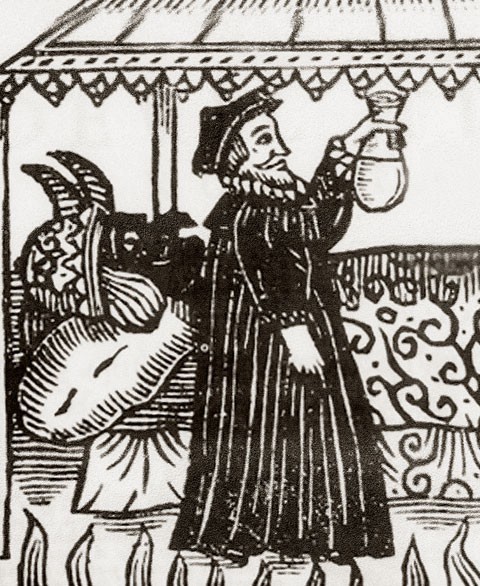
Detail of a woodcut print, 1641. A physician tests the water of Pluto, the Papist devil, in a glass urinal. (Ernst and Johanna Lehner, Devils, Demons, and Witchcraft [New York: Dover Publications, 1971], fig. 238.)
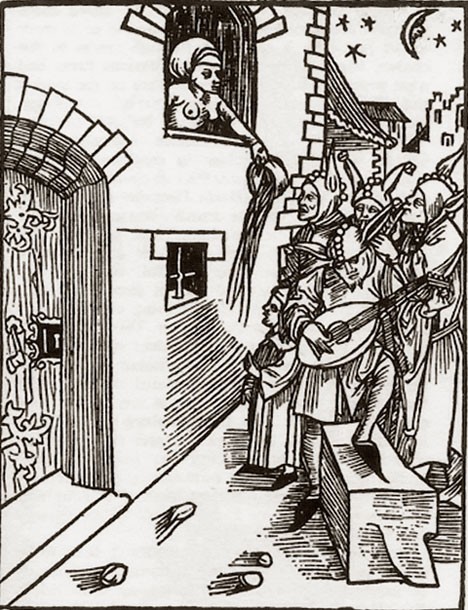
So much for carol singers! The source of this late medieval woodcut is not known, but if it has not been redrawn, it provides one of the earliest renditions of the conventionally shaped chamber pot. (Wallace Reyburn, Flushed with Pride [London: Pavilion Books, 1989], p. 49.)
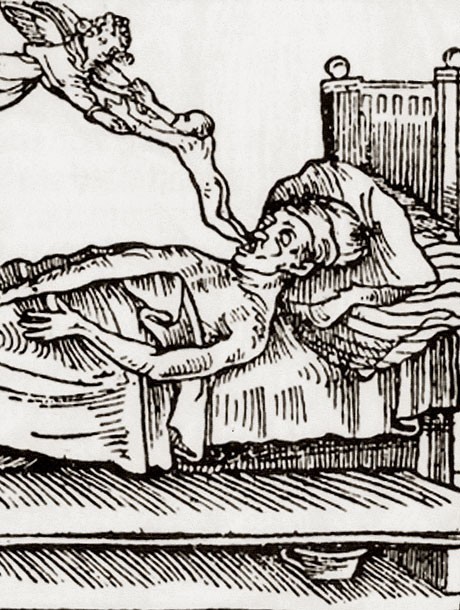
A shallow chamber pan beneath the bed of a dying man. Detail from Mortilogus, Augsburg, 1508. (Ernst and Johanna Lehner, Devils, Demons, and Witchcraft [New York: Dover Publications, 1971], fig. 182.)
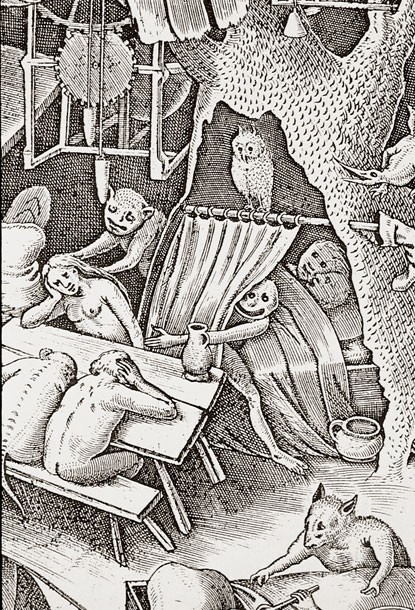
Detail from Peter Bruegel the Elder’s Sloth in his series of the Seven Sins, 1557. The chamber pot beside the bed of the lazy sinners is a fully developed form with both rim-attached handle and defined foot. (H. Arthur Klein, Graphic Worlds of Peter Bruegel the Elder [New York: Dover Publications, 1971], p. 211.)

Detail from Peter Bruegel the Elder’s Charity, 1559, depicting a carefully drawn and laterally ribbed chamber pot beside a sick bed. Another, whose shape resembles that in his Sloth, hangs at the attic level where it serves as a nesting place for insect-eating swallows. (H. Arthur Klein, Graphic Worlds of Peter Bruegel the Elder [New York: Dover Publications, 1971], p. 227.)

A woodcut illustration from a ca. 1625 English ballad titled “A Statute for Swearers and Drunkards” showing a chamber pot under the tavern table. (A Pepysian Garland, edited by Hyder E. Rollins [Cambridge, Mass.: Harvard University Press, 1971], p. 109.)
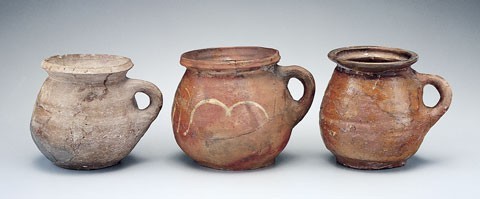
Side-handled dippers. Left: Bruge, early sixteenth century. Gray proto-stoneware. H. 6 1/8". Center: Probably Bergen-op-Zoom, mid- to late sixteenth century. Lead-glazed earthenware with white-slip decoration. H. 6 1/4". Found in Bruge. Right: Bruge, sixteenth century. Lead-glazed earthenware. H. 6 1/4". (Noël Hume Collection; all photos by Gavin Ashworth unless otherwise noted.)
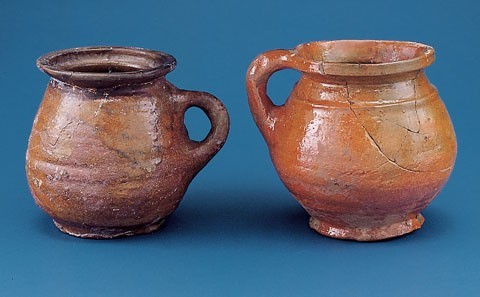
Side-handled dipper and chamber pot. Left: Bruge, sixteenth century. H. 6 1/4". Right: Rotterdam, sixteenth century. Lead-glazed earthenware. H. 6 3/4". (Noël Hume Collection.) Similar vessel but with the handle attached to the rim after the potter changed his mind. Note vestigial frilled foot characteristic of sixteenth- and seventeenth-century Dutch chamber pots.

Detail of the pot illustrated on the right in fig. 9 showing plugged indentation where the dipper handle should have been anchored.

Chamber pots, Netherlands, lead-glazed earthenware. Redware chamber pots from Rotterdam and Amsterdam, all with full or vestigial frilled feet. Left and right foreground: sixteenth century. H. 5 7/8" and 5 1/8". Top left: seventeenth century. H. 5 1/4". Center: Interior green-slipped and handle pinched at the crest, first half of the seventeenth century. H. 5 5/8". Top right: Angular profile and pinched handle, mid- to late seventeenth century. H. 4 3/8". (Noël Hume Collection.)

Probable redware chamber pot fragment, Southwark, London, sixteenth century. D. 6 1/2". (Ex-collection Sir David Burnett.) Note the Dutch-style frilled foot.
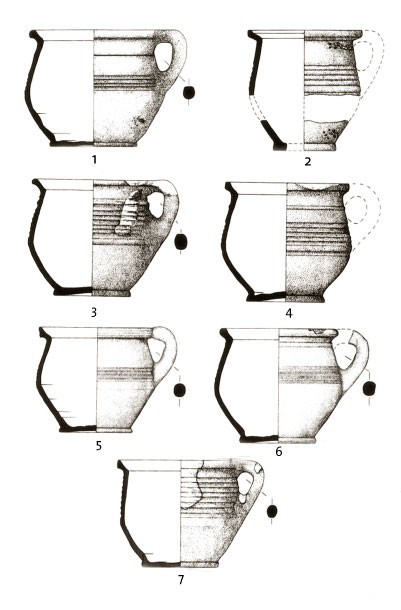
Redware chamber pot profiles from the Thomas Ward kilns at Martin’s Hundred, Virginia. (Courtesy, Colonial Williamsburg Foundation.) 1 from the fort well; 2–4 from the potter’s pond, all before 1622; 5–6 from the Ward site, ca. 1623–1635; and 7 from the Harwood plantation site but likely to be pre-massacre.
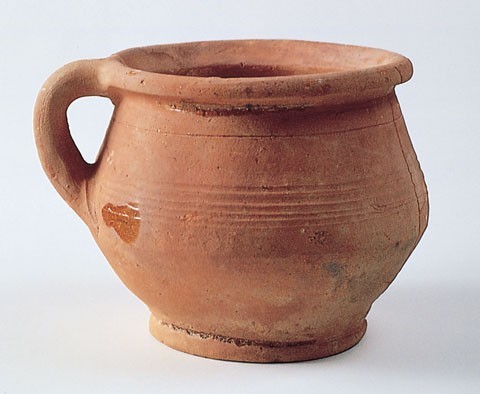
Chamber pot, Virginia, ca. 1620–1622. Unglazed earthenware. H. 6 1/4". (Courtesy, Department of Archaeological Research, Colonial Williamsburg Foundation.) Unglazed redware chamber pot from the fort well at Wolstenholme Towne in Martin’s Hundred, Virginia. See fig. 13, no. 1

Chamber pot, London, mid- to late seventeenth century. Earthenware. H. 6 1/8". (Ex-collection Sir David Burnett.) Typical London redware chamber pot with internal lead glaze and external ornamental lateral grooves similar to those on pots from Martin’s Hundred. The well-made handle is vertically channeled and squeezed at the crest, perhaps in the Dutch manner. Found in Southwark.
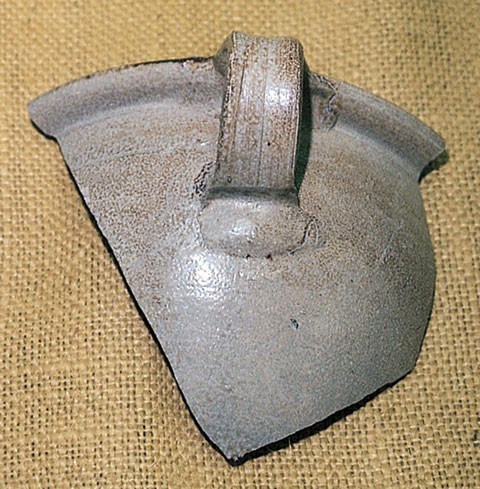
Chamber pot from the Harwood Plantation site at Martin’s Hundred, Virginia. (Department of Archaeological Research, Colonial Williamsburg Foundation.) Rim and wall fragment from a Rhenish gray-to-brown stoneware chamber pot, the first of its kind found in America. Recovered from an abandoned storehouse cellar, ca. 1625–1640.

Chamber pots, Germany. Stoneware. H. 5" and 5 1/4". (Noël Hume Collection.) Excavated in Holland. Left: a close parallel for the Martin’s Hundred fragment, ca. 1625–1640. Right: Somewhat taller and more bulbous, and perhaps dating later in the seventeenth century.
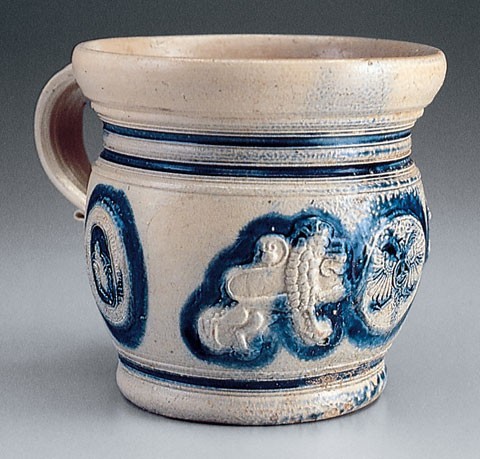
Chamber pot, Westerwald, 1632. Salt-glazed stoneware. H. 6 1/8". (Noël Hume Collection.) A gray and blue stoneware chamber pot with everted and internally dished rim, its wall decorated with sprig-applied crowned lions flanking a central double-eagle badge, and oval side medallions featuring a waist length male figure surrounded by a partially legible inscription and the date 1632. Found in Amsterdam.
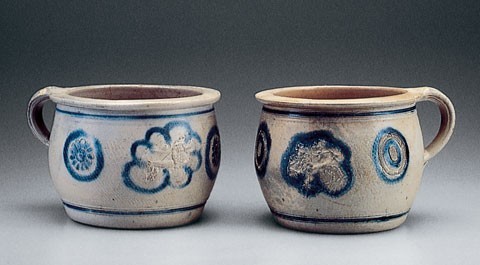
Chamber pots, Westerwald, 1710–1780. Salt-glazed stoneware. H. 5 3/8". (Noël Hume Collection; ex-collection Frank Thomas.) Typical of those in the export trade from ca. 1710 to 1780. Left: decorated with sprigged lions and impressed rosettes; Right, less commonly, applied oval medallions with hatched centers. Believed to have been found together, probably in London.

Chamber pot, England, 1600–1650. Earthenware. H. 6 1/8". (Noël Hume Collection.) Border ware chamber pot of oV-white color, coated internally with a clear lead glaze in contrast to the brown run marring the exterior.
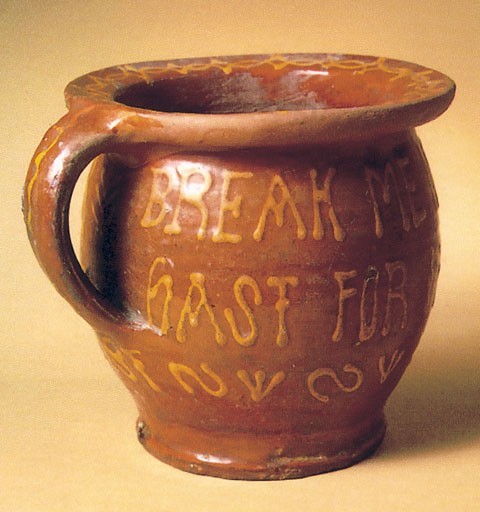
Chamber pot, Essex, England, 1650–1665. Slipware. D. 7". (Photo courtesy Jonathan Horne.) The slip inscription on this “Metropolitan” type chamber pot reads: break me not i pray in youer hast for i to non will give destast. A parallel example in the Museum of London is dated 1651.

Chamber pot, Donyatt ware, 1680–1700. Earthenware. H. 6 3/4". (Chipstone Foundation.) The lead-glazed combed slip over a buV body is in a style more characteristic of StaVordshire. The pot was retrieved from a kiln site and is considered to be a waster.
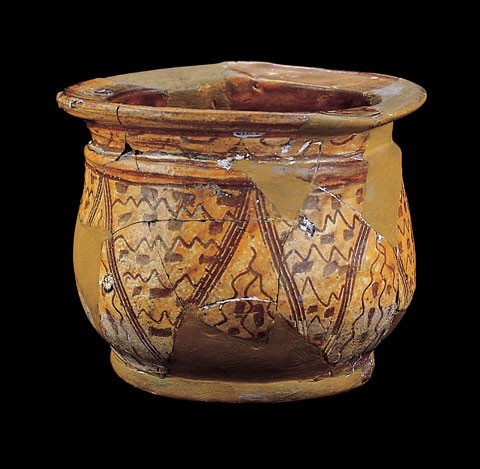
Chamber pot, North Devon, ca. 1670–1680. SgraYto slipware. H. 5 1/2". (National Park Service, Colonial National Historical Park, COLO J 7369.) The rim is inscribed under the glaze with the initials WB and 16, the rest of the date missing. Probably from a Bideford kiln.
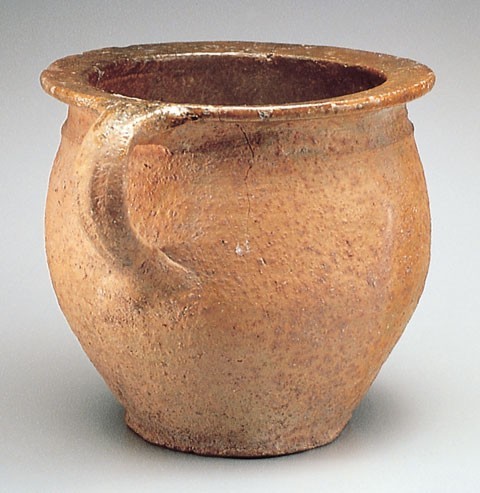
Chamber pot, North Devon, 1660–1700. Lead-glazed earthenware. H. 7 3/4". (Chipstone Foundation.) This pot’s gravel-tempered body is internally lead glazed in mottled green and brown. A product of a Barnstaple or adjacent Fremington kiln.
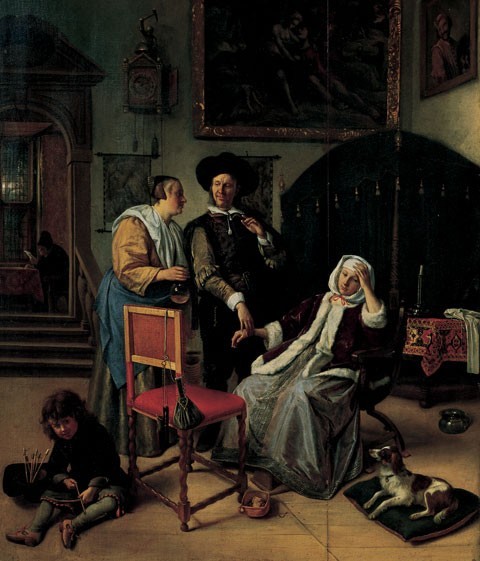
Jan Steen, The Physician’s Visit, ca. 1655. Oil on panel. (Collection of the Wellington Museum [WM 1525–1948], Victoria and Albert Picture Library, London.) This painting shows a silver or pewter chamber pot, ca. 1655, beside the bed and a glass urinal in the hand of the nurse.
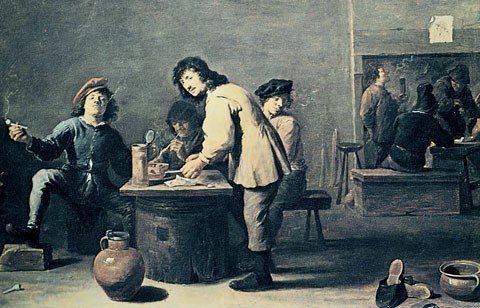
David Teniers, Jr., The Smokers. (Photograph and attribution provided by author.) A green-glazed chamber pot is in the right foreground. Although attributable to the mid-seventeenth century, its shape is similar to those in use in southeast England at the beginning of the eighteenth century.
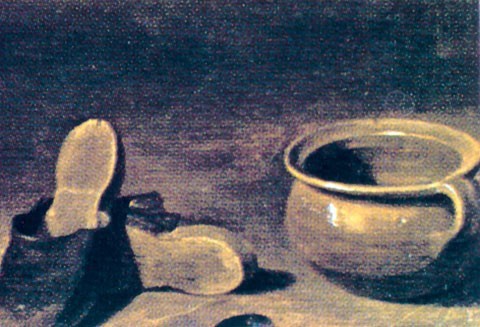
Detail of the painting illustrated in fig. 26 showing chamber pot.

Chamber pot and plate fragment, England, ca. 1700–1720. Earthenware. H. 5 1/2". (Noël Hume Collection; ex-collection Sir David Burnett.) This green-glazed, buV-bodied chamber pot was common in London in the early eighteenth century, characterized by a flat, beaded-edged rim. Shown with it, a small plate of the same ware and rim characteristic; found in Southwark.

Chamber pot, London, ca. 1750. Earthenware. H. 5 1/2". (Noël Hume Collection.) Probably made in or near London in the mid-eighteenth century, this lead-glazed, redware chamber pot is characterized by a narrow and square cut rim.
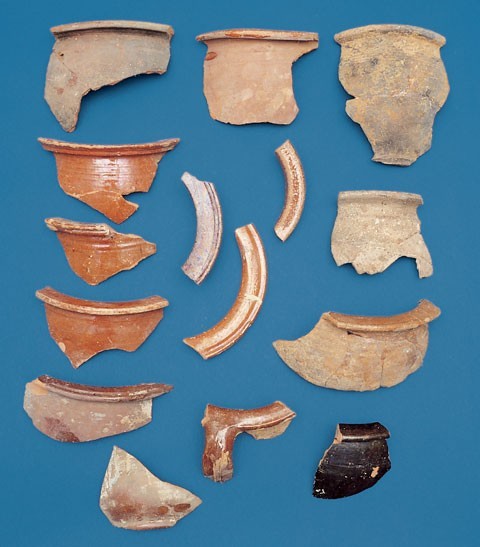
Examples of redware chamber pot rims of the seventeenth and eighteenth centuries, all from a single Southwark construction site. The example at bottom left had been used as a paint pot. (Ex-collection Sir David Burnett.)
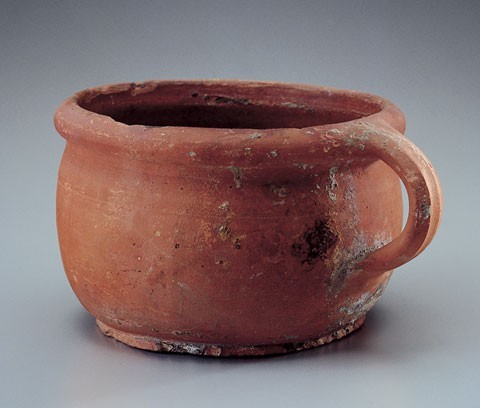
Chamber pot, London, 1820–1860. Earthenware. H. 5 1/8". (Noël Hume Collection.) Redware chamber pot internally lead glazed and characterized by a folded and rounded rim. These thick and stolid pots were often made for or used by commercial painters. This example retains traces of both white and green paint.
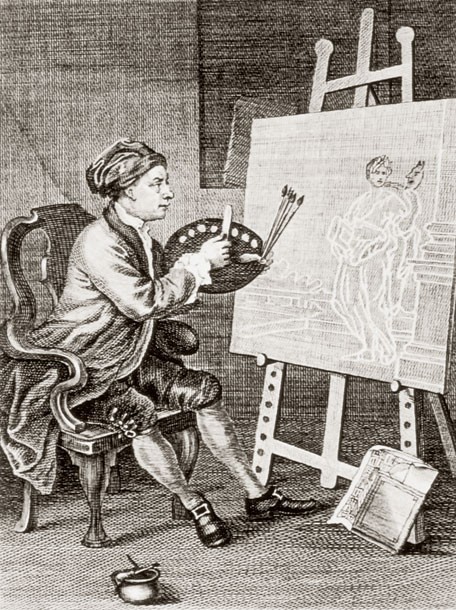
William Hogarth, self-portrait, London, 1764. Engraving. (Private collection.) The artist is shown with a paint or oil container of small chamber-pot shape beside him.
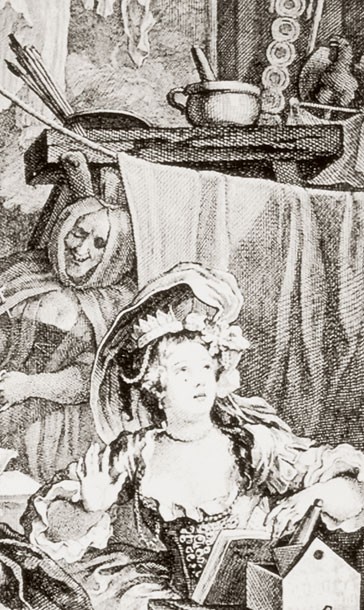
Detail of William Hogarth’s engraving, Strolling Actresses Dressing in a Barn, London, 1738. (Private collection.) This image includes a scene-painter’s chamber pot with a pestle (?) resting therein and a pallet and brushes beside it.

Chamber pot, probably France, late eighteenth century. Earthenware. H. 5 1/4". (Noël Hume Collection.) This redware pot has a thin internal lead glaze that is dirty green in color. The rim is slightly everted and folded into a weak oval profile. The missing handle (now restored) had been poorly attached and probably broke away when the pot was being emptied from a ship into the harbor at Hamilton, Bermuda.
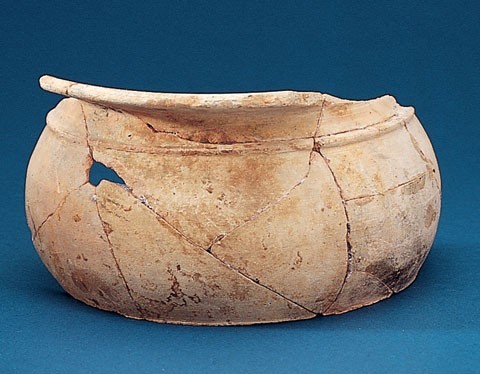
Chamber pot fragment, London, 1650–1675. Tin-glazed earthenware. H. 4". (Ex-collection Sir David Burnett.) Delftware chamber pot of the earliest shape, the body squat, the rim flattened, and a sharp ridge at the shoulder. The biscuit (once fired) example was found on the site of Christian Wilhelm’s Pickleherring factory and dates from the third quarter of the seventeenth century.
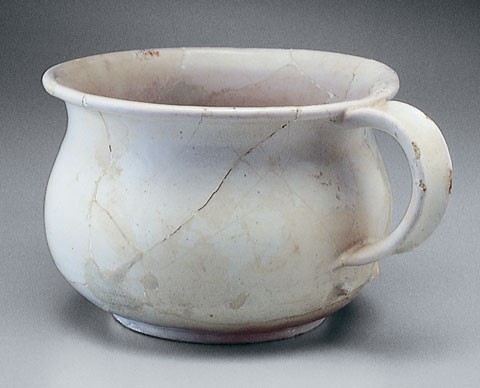
Chamber pot, London, 1700–1725. Tin-glazed earthenware. H. 5 1/8". (Noël Hume Collection.) Delftware chamber pot attributable to the first quarter of the eighteenth century.

Chamber pots, England, 1725–1775. Tin-glazed earthenware. H. 4 5/8", 5 1/16" and 5 1/2". (Department of Archaeological Research, Colonial Williamsburg Foundation.) Examples of delftware chamber pots from excavations in Williamsburg, Virginia, illustrating their evolution from the second to third quarters of the eighteenth century. Their archaeological contexts are post 1750, ca. 1760, and none.

Chamber pot fragment, England, 1710–1730. Tin-glazed earthenware. (Department of Archaeological Research, Colonial Williamsburg Foundation.) Fragments from blue decorated delftware chamber pots found at the Timberlake and Dana site in Williamsburg, Virginia.
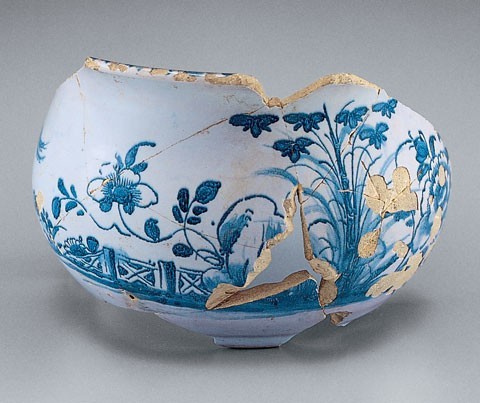
Chamber pot fragment, England, 1750–1760. Tin-glazed earthenware. (Department of Archaeological Research, Colonial Williamsburg Foundation.) Fragmentary blue decorated delftware chamber pot from the Roscoe Cole House site in Williamsburg, Virginia.
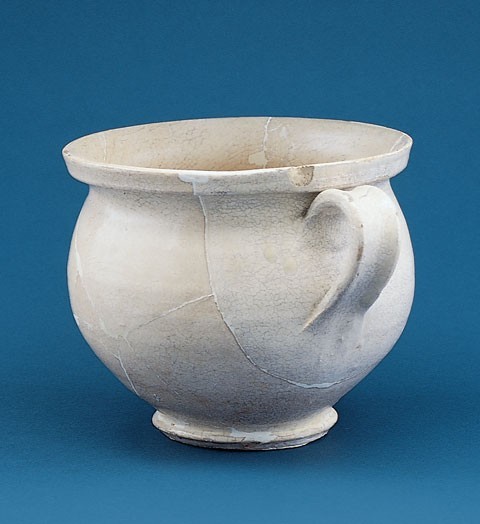
Chamber pot, Italy, 1750– 1800. Tin-glazed earthenware. H. 5 3/8". (Noël Hume Collection.) An undecorated maiolica chamber pot with everted and square-cut rim. Excavated in northern Italy.
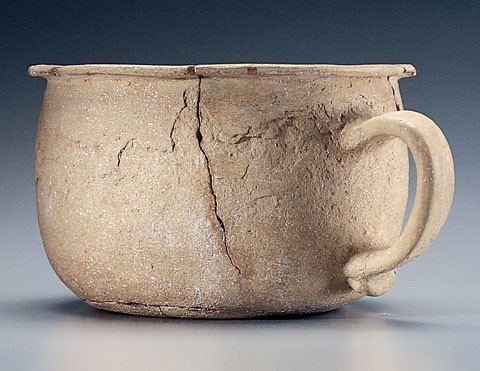
Chamber pot, Virginia, 1750–1770. Unglazed earthenware. H. 4 7/8". (Department of Archaeological Research, Colonial Williamsburg Foundation.) This type of ware is referred to as Colono-Indian. The hand-shaped chamber pot is clearly an attempt to copy a European shape in either delftware or white salt-glazed stoneware. The reddish buV body is shell tempered. Note the lower handle terminal created from a separate pad of clay rather than having been drawn out as an extension of the handle. Discarded ca. 1770.

Chamber pot, StaVordshire, 1725–1750. Salt-glazed stoneware. H. 5 1/8". (Department of Archaeological Research, Colonial Williamsburg Foundation.) White salt-glazed stoneware chamber pot whose thinness allowed the potter to exercise his talent in a way reminiscent of Hogarth’s “Line of Beauty.” The pot came from an archaeological context of ca. 1770.
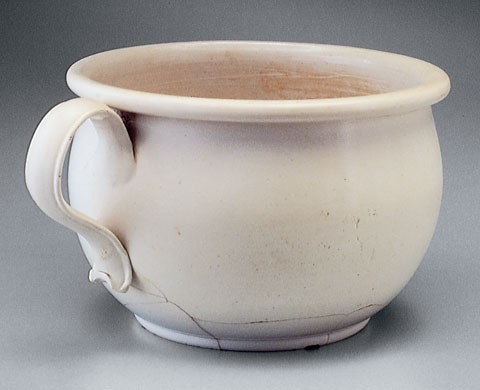
Chamber pot, StaVordshire, 1760–1780. Salt-glazed stoneware. H. 5 3/8". (Noël Hume Collection.) The white salt-glazed chamber pot in decline, its early elegance lost and the rim reduced to an everted roll.
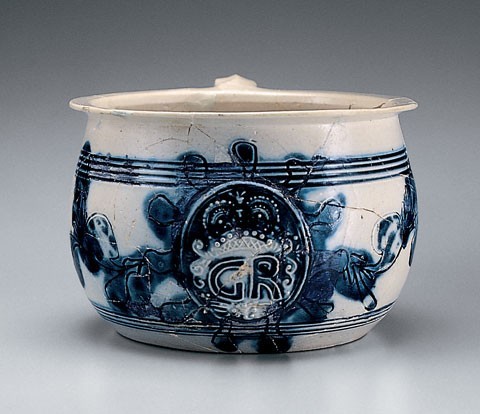
Chamber pot, StaVordshire, 1770–1790. Salt-glazed stoneware. H. 4 11/16". (Department of Archaeological Research, Colonial Williamsburg Foundation.) English debased scratch-blue decorated white salt-glazed stoneware chamber pot, decorated in the style of Westerwald but with the addition of the GR royal initials, an impertinence that the Germans had always avoided.
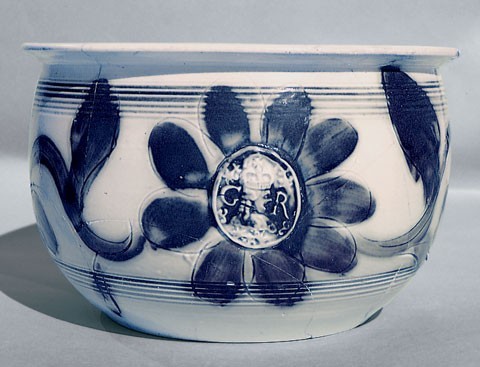
Chamber pot, Staffordshire, 1760–1775. Salt-glazed stoneware. H. 4 3/4". (Alexandria Archaeology Museums, City of Alexandria, Virginia; photo courtesy Richard Muzzrole.) A similar pot somewhat better painted and decorated with a profile portrait of George III flanked by his GR initials. Found in an Alexandria privy in an early-nineteenth-century
context.
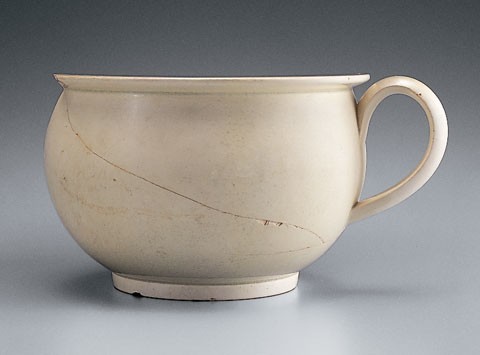
Chamber pot, England, 1775–1800. Creamware. H. 5 5/16". (Department of Archaeological Research, Colonial Williamsburg Foundation.) Undecorated English creamware chamber pots were exported in large numbers. This typical example from Williamsburg excavations features a flat rim and a simple strap handle. Others were more elaborate and came laterally ribbed and with rolled rims.

Chamber pot, StaVordshire, 1810–1820. Pearlware. H. 4 7/8". (Ex-collection Sir David Burnett.) Blue transfer printed with a widely used print of Nuneham Court in Oxfordshire.
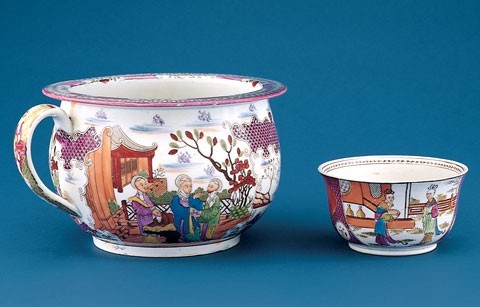
Chamber pot and bowl, Staffordshire, 1800–1810. Pearlware. H. 5 3/16" and 2 5/8". (Noël Hume Collection.) A chamber pot elaborately decorated with a black-transfer print intended as guidance for complex polychrome hand painting in the Chinese manner. Accompanying the chamber pot is a similarly decorated bowl whose very shallow foot suggests that it may have been intended as a shaver’s soap dish.
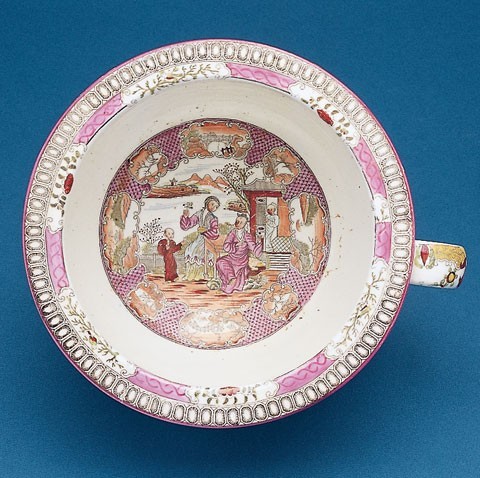
View of the chamber pot illustrated in fig. 48. This interior is richly hand painted onto a transfer design copying that on a bone china plate from the factory of Miles Mason of Lane End, ca. 1805.
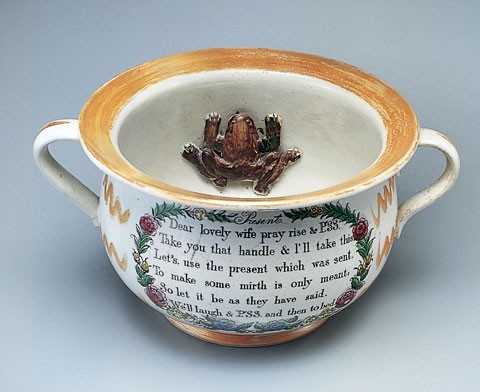
Chamber pot, Sunderland, 1830–1850. Pearlware. H. 5". (Private collection.) A double-handled, transfer-printed and hand colored chamber pot designed as a humorous wedding gift. Such pots were relatively common, but their distribution is likely to have been restricted to the rural north of England, such humor not being appreciated in an increasingly straight-laced Victorian urban south. There are several minor variations, some with Sunderland’s characteristic luster adornments. As shown in figures 51 and 52, the interior print came as viewers either young or old, perhaps reflecting the age of the newlyweds. Frogs also were optional.
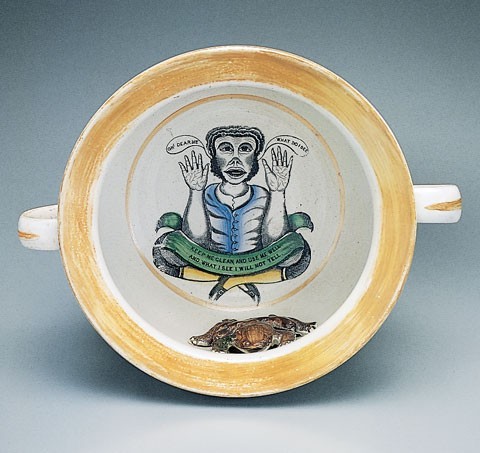
Detail of the interior of the chamber pot illustrated in fig. 50.
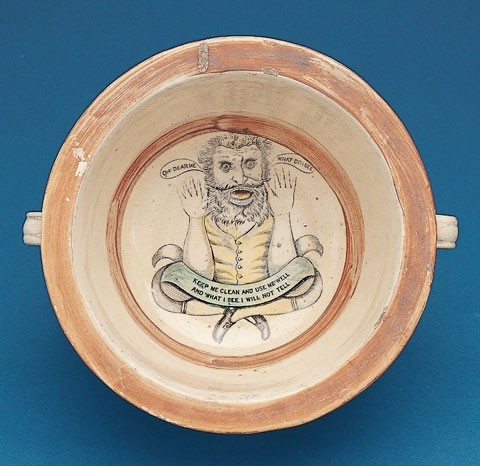
Interior view of the Sunderland chamber pot illustrated in fig. 54. (Noël Hume Collection.)
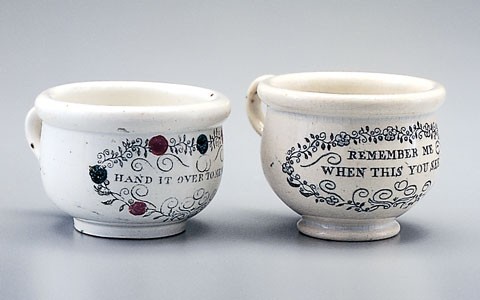
Miniature chamber pots, 1840–1870. Whiteware. H. 2 1/2" and 2 1/4". (Noël Hume Collection.) Each has a transfer-printed inscription. Both were almost certainly made for sale at fairgrounds or they may have been given away as inducements to purchase more necessary wares.
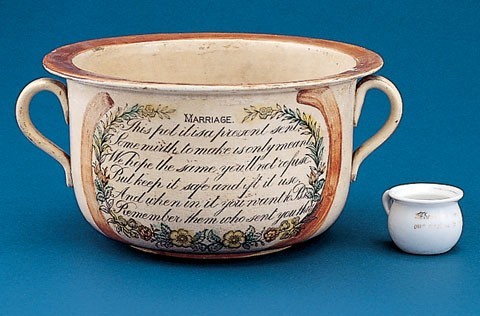
Miniature chamber pot marked germany, early twentieth century. Porcelain. H. 1 5/8". (Noël Hume Collection.) The side has a gilded inscription reading: there are times when / one desires to be alone. The interior bottom is enriched with a transfer-printed and hand-colored human eye beneath a gilded inscription reading “Goo Goo.” The full sized pot is included for scale but shows the reverse side of fig. 52.

Interior view of the miniature chamber pot illustrated in fig. 54.
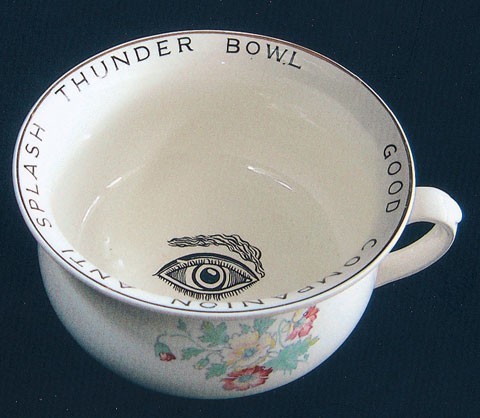
Chamber pot, England, ca. 1935–1940. Whiteware. H. 5 1/4". (Noël Hume Collection.) Decorated with a weak polychrome floral print on one side. A black eye is printed inside and the rim inscribed good companion anti spash thunder bowl. Marked “Made in England.”

Chamber pot, miniature, Lancaster Ltd., Hanley, England, 1939–1940. Whiteware. H. 1 1/2". (Noël Hume Collection.) A morale-building, humorous toy printed internally with a profile of Adolf Hitler and inscribed both inside and out adolf in poland. Maker’s mark on base.
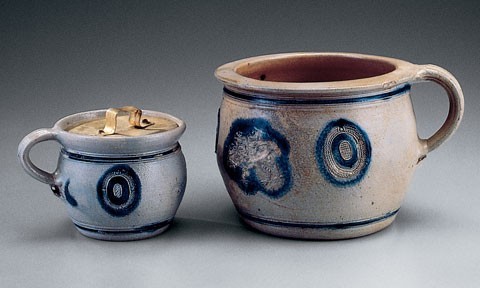
Soap dish and lid, Germany, ca. 1750. Salt-glazed stoneware. H. 3 3/4". (Noël Hume Collection.) Westerwald gray and blue stoneware vessel of small chamber pot shape, but thought to have been intended as a shaver’s soap dish. The sprigged cartouche parallels those on some full-sized Rhenish chamber pots like the example on the right. Both the pot and its brass lid were found in situ in an Amsterdam privy.

A loop-handled Westerwald stoneware parallel for figure 58 found by diver-conservator William Gillies on an unidentified Bermuda shipwreck of ca. 1740–1750. H. approx. 3 5/8". (Courtesy, William Gillies.)
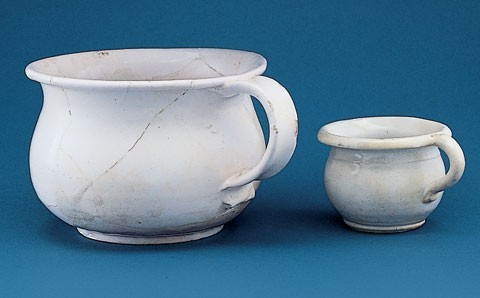
Miniature chamber pot, Netherlands, 1700–1730. Tin-glazed earthenware. H. 3". (Noël Hume Collection.) A full sized chamber pot illustrated in figure 36 is included for scale next to the Dutch delftware vessel of chamber-pot shape.
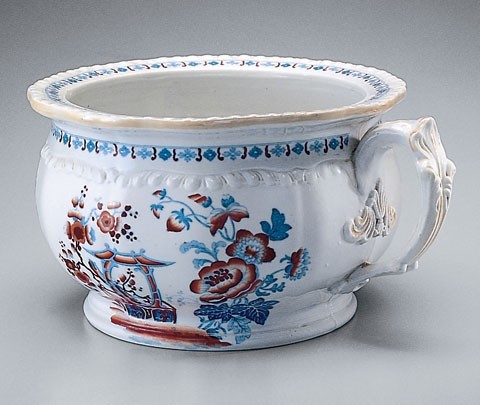
Chamber pot, StaVordshire, ca. 1825. Stone china. H. 5 3/4". (Noël Hume Collection.) This chamber pot was cast in a two-piece mold whose junction lines have not been removed; it is transfer printed in blue overlaid in hand-applied red. The chinoiserie pattern is reproduced internally, and the exterior rim and shoulder are molded in a bead-and-reel design reminiscent of white salt-glazed stoneware plate rims. The elaborately molded and gilded handle is enriched with a separately applied upper terminal. The base is marked with the kind of badge allowed to companies that had been granted its usage by Royal Appointment.
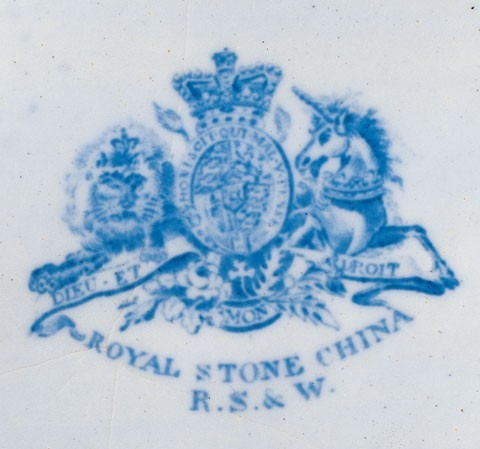
Detail of the printed mark on the base of the chamber pot illustrated in figure 61. The associated inscription declares itself to be that of a manufacturer of ROYAL STONE CHINA from the factory of R. S. & W. The company is believed to be that of Stevenson and Williams, a short-lived Cobridge partnership of ca. 1825, but there is no known evidence that it enjoyed royal patronage. The English royal arms are charged with the cap or crown of Hanover and therefore date prior to the accession of Queen Victoria in 1837.

Chamber pots, American, 1790–1810. Salt-glazed stoneware and lead-glazed earthenware. H. 6 3/4" and 6 1/4". (Courtesy, Department of Archaeological Research, Colonial Williamsburg Foundation.) Examples of American chamber pots used in the lunatic asylum at Williamsburg, Virginia, ca. 1790–1810. The redware pot is possibly from the factory of Henry Piercey in Alexandria, whereas the stoneware example is likely to have been made either in Philadelphia or Baltimore.

Chamber pot, England, ca. 1838. Whiteware. H. 5 15/16". (Courtesy, Department of Archaeological Research, Colonial Williamsburg Foundation.) This chamber pot was initialed specifically for the Williamsburg Lunatic Hospital whose name was changed in 1838. Believed to be English, but the initials may have been added by an American importer.

Chamber pots, England, 1860–1885. Whiteware. H. of tallest: 5 7/8". (Courtesy, Department of Archaeological Research, Colonial Williamsburg Foundation.) Three among several fire-blackened, heavy-duty ironstone-type chamber pots found in the debris of the 1885 fire that destroyed the Williamsburg asylum.

Detail from an engraving illustrating Jonathan Swift’s A Tale of a Tub (1751 edition), showing the chamber pot as a means of expression.
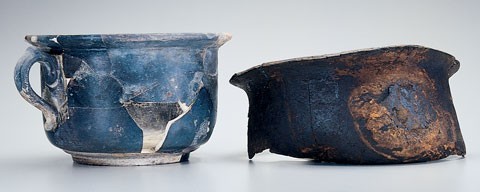
Chamber pots, England, ca. 1880. Whiteware and vulcanized rubber. H. 5 3/8". (Courtesy, Department of Archaeological Research, Colonial Williamsburg Foundation.) Another ironstone-type chamber pot from the Williamsburg asylum’s 1885 fire shown alongside the remains of a vulcanized chamber pot intended for the use of unruly patients.
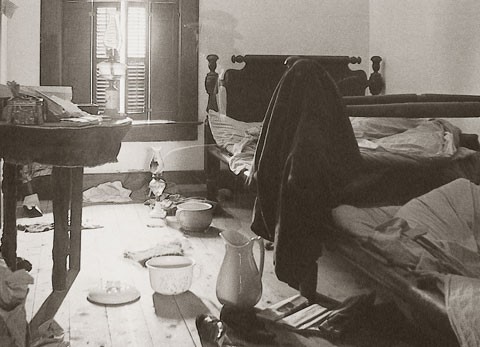
Print from a glass negative. (Courtesy, David Doody and the Image Alchemy Inc. Collection.) This photograph, perhaps shot in a New Orleans flop house, shows typical turn of the twentieth-century chamber pots more or less in use. Note the ghost image of one of the room’s occupants seated on the bed.
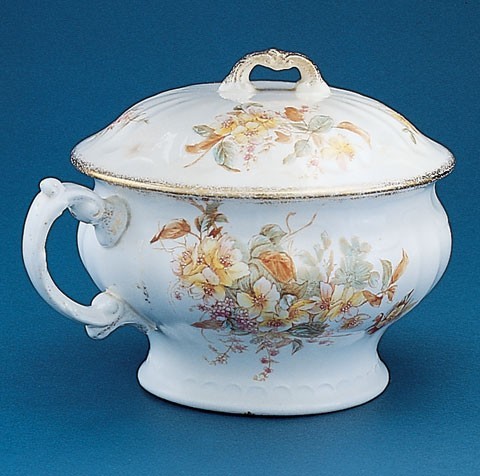
Chamber pot and lid, Maddock’s Lamberton Works Royal Porcelain, Trenton New Jersey, ca. 1892. H. 5 3/4". (Noël Hume Collection.) A massive, lidded chamber pot of hotel-china whiteware, gadroon molded and decorated with transfer-printed polychrome floral sprays and spatter gilding. Though mold-made, the marks have been almost entirely erased. There are tripod stilt marks scarring the interior base suggesting that the pot was fired upside down.
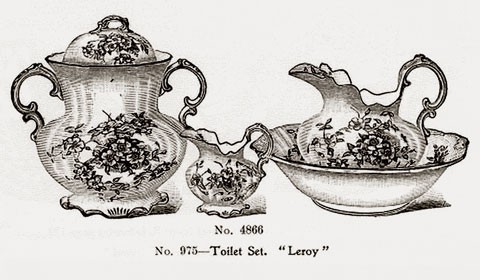
Catalog illustration, Messrs. Higgins & Seiter, New York, 1899. In the late nineteenth century chamber pots were commonly sold in sets of a dozen, though social sensitivity kept them from being pictured in the ads.

Chamber pots, England, ca. 1880 and 1900. Whiteware. H. 5 3/4" and 5 1/2". (Noël Hume Collection.) Examples of diverse late Victorian chamber-pot taste. The left hand cream-colored example is molded below the girth with a basketry pattern that continues onto the unusual bifurcated handle. The upper wall and rim are transfer printed in sepia in an elaborate pattern of storks, fans, twigs, flowers, and a boy apparently pursuing a butterfly. However, the pattern is inverted and presumably intended to complement an equally decorative lid. No maker’s mark, but printed with a diamond-shaped design registration mark for August, 1880. The pot recalls the enthusiasm for Japanese textiles and ceramics that burgeoned in the late nineteenth century. The unmarked example on the right is a whiteware reminder of a paralleling taste for contrasting colors and fluid lines loosely related to the art nouveau movement.
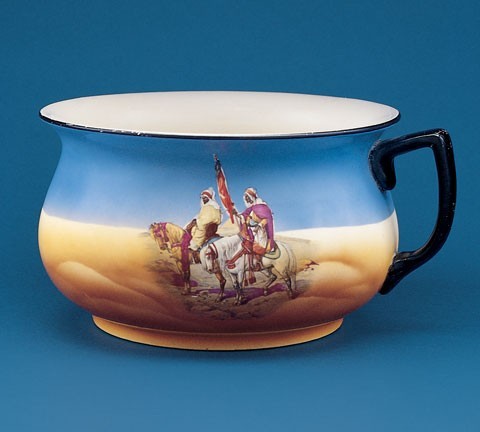
Chamber pot, England or possibly North Germany, ca. 1920–1930. Whiteware. H. 5 1/4". (Noël Hume Collection.) Titillating dreams of Bedouin tents, Arab sheiks, and fates definitely not worse than death, may have been fostered by transfer-decorated pots like this from the 1920s.
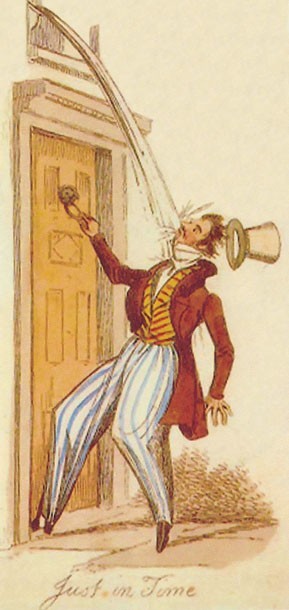
“Just in Time.” Hogarth would have called this a “Tail Piece.” (Mary Evans Picture Library.)
Many of us wish we had been born with names other than our own, and the mid-seventeenth-century English gentleman Mr. Chamberley may have been one of them. Armorial historian Randle Holme described his heraldic badge thusly:
He beareth sable, a chamber pot, or a Bed pot Argent. This is by the Jolly crew when met togather ouer a cup of Ale; not for modesty sake, but that they may se their owne beastlynesse, in powering in, and casting out more than sufficeth nature, which if it went not suddenly downwards, would force its way vpwards, is called a Lookinge glasse; But there is nothing neuer so vsefull, but it may be abused, so is this when it is called by such persons a Rogue with one eare, and a pisse pot.[1]
We may safely assume that the history of the chamber pot goes back to the first time hygienists decided that urinating on the floor should be discouraged—at least in polite society.[2] It is equally safe to suppose that the earliest chamber pots were not made specifically for that purpose, but any earthenware pots that came to hand would suffice. When, therefore, were the first pots produced with that evacuatory function in mind?[3]
Limiting myself to English literary sources—which precede British genre paintings by three hundred years and are more accurately datable than are most pots dug from the ground—the earliest seem to date from the first decade of the fifteenth century and refer to chamber pots as “jordans,” a term previously applied to glass flasks used by physicians to study the “humors” in urine (figs. 1, 2). I found the illustrated example in a circa 1500 context in London.[4] That pottery vessels were used in the same way is described in Holinshed’s Chronicles (ca. 1577) wherein “A lewd fellow that took upon him to be skilfull in physicke . . . was set on horsebacke, with his face towards the tail . . . and so was led about the citie . . . with two jorden pots about his neck.”[5]
Late medieval woodcuts and engravings sometimes demonstrated the use of the contents as a means of expression, and when others depicted people in bed (fig. 3), they usually provided some kind of pot beside or under it; but woodcuts being as crude as they were, there is not a lot to be learned from them other than that shallow, sometimes handleless pans were so used—which may justify the term “slops” being employed in that connection (fig. 4).[6] By the mid-sixteenth century, and with the availability of engravings copied from genre paintings by Peter Bruegel the Elder and others, we find that chamber pots of now-conventional shapes had become familiar household assets, as, indeed, they were in English taverns at the beginning of the seventeenth century (figs. 5-7). But whether they were of silver, pewter, or common clay is often hard to tell.[7]
The earliest ceramic examples in the Noël Hume Collection reportedly date from the late fifteenth to sixteenth centuries and were found at Bruges in modern Belgium. All three differ from those in contemporary illustrations by having their ear-like handles projecting from their bulbous girths rather than being attached to the rims as are those of most later pots.[8] Reportedly, the earliest of them was made in a hard, brownish, gray ware often described as Flemish proto-stoneware. The pot contains a yellowish sediment in which are imbedded drops of pale pink wax. More clings to the rim at one side and so is suggestive of pouring, and thereby raises doubts that these side-handled vessels were, indeed, chamber pots. The placement of the handle in the upper wall of the pots, rather than attached to the rim, causes the vessel to tip when held by it—a feature undesirable in a chamber pot but right for a milk dipper or skimmer (fig. 8).[9] Dutch collections do include vessels with side handles that are so identified, although in most instances they are of much later dates.[10]
The two pots shown in figure 9 are very similar in profile, one having its handle at the shoulder and the other at the rim. Like the other dippers, that on the left exhibits interior indentations (or filled holes) corresponding with the handle’s points of attachment. The pot on the right has similar indentations, but that at the top had been plugged with clay when the potter realized that he was applying a handle for a chamber pot rather than for a dipper (fig. 10). So what can this change of intent be telling us?
It implies that Dutch earthenware dippers and chamber pots were being made at approximately the same date. But the evidence of the proto-stoneware example (see fig. 8, left) may be telling us that bag-shaped dippers were in production earlier than were chamber pots. Does this mean that dippers were previously also used as chamber pots until someone discovered that the handle was in the wrong place? If that is true, then the two pots in figure 9 represent the first step in the evolution of the true chamber pot.
The third Bruges dipper differs from the others, being in a hard redware with only rudimentary external glazing, but ornamented with slip-applied swags (see fig. 8, center). This decorative style is attributed to the once-important Netherlandish potting center at Bergen-op-Zoom.[11]All three dippers are bag-shaped, flat bottomed, and lack feet. Indeed, the absence of defined bases on the Bruges pots sets them apart from most Netherlandish chamber pots of the sixteenth century which, even in the rudimentary treatment afforded such pots in Bruegel’s paintings and engravings, possess recognizable basal definition.
The Noël Hume Collection’s lead-glazed pots found in the Netherlands demonstrate the wide range of shapes used there in the sixteenth and seventeenth centuries (fig. 11). All have crinkled feet, but in every other respect they differ one from another.[12] Although close dating is not yet possible, it is fair to say that the examples in the left and right foreground belonged to the sixteenth century (the left earlier than the right), and that the green-glazed pot in the center was a product of the first half of the seventeenth century.[13] The flat-rimmed example behind it to the left in most respects appears to stem from the same period, but the flattened and beaded-edged rim would, in England, be consistent with a date as late as the early eighteenth century. The fifth pot (right rear) is of a shape that should date it to the second half of the seventeenth century.
E. M. Ch. F. Klijn’s invaluable Lead-glazed Earthenwares in The Netherlands, cataloging the collection at the Open Air Museum at Arnhem, illustrates twenty-six chamber pots, five of them attributed to the period 1575–1625, all different, and all from disparate locations.[14]Three questions immediately present themselves: Do the shape variations represent regional differences? How reliable are the dates and what is the documentation for them?
In the study of sixteenth-century earthenwares, we are hampered by the dearth of tightly datable archaeological contexts, and also by the fact that when broken into small pieces, chamber pots can be difficult to identify. Rims that are internally concave or dished (as is one of the Bruges examples) can be mistaken for pipkins which were usually made to receive a lid, were it of earthenware, wood, or even copper alloy.
Very little information is available to identify English chamber pots of the early Tudor era, but a base with a crinkled foot-ring found in the London suburb of Southwark might be from such a pot—but then again it might not (fig. 12).[15] A large, single-handled bowl found in Norwich has a similarly contoured foot, and although having but one handle, it is identified as a Dutch cauldron.[16] However, none of the twenty-seven cauldrons illustrated in E. M. Ch. F. Klijn’s previously cited book has single handles, nor crinkled feet.
In writing about the Dutch-type wares found in Norwich, archaeologist Sarah Jennings encapsulated the identification problem when she wrote:
Local potteries copied extensively the limited range of forms imported into Norwich, and produced vessels indistinguishable from their Dutch counter-parts. They all have some of the distinctive characteristics of the Low Countries products, such as pinched handles, a tripod base, pinched feet, a ring-base or a collar rim.[17]
There can be no denying that the origins of the cited features are Dutch. An example in the Noël Hume Collection excavated in Amsterdam has a pronouncedly crinkled foot and is thought to date from the mid-sixteenth century. The Museum of London’s post-medieval ceramics expert, Jacqueline Pearce, is of the opinion that the Southwark fragment is Dutch—which leaves one wondering why an object so easily replicated in England would have been imported.[18]
In spite of the fact that many more archaeological reports providing drawings and descriptions of medieval and later earthenwares have been published in England than abroad, much of the tightest dating for early seventeenth-century wares comes from American excavations on British colonial sites.[19] This is certainly true of chamber pots whose manufacture in Virginia’s Martin’s Hundred between circa 1620 and 1645 provided a well-dated and documented range and provenance for locally made examples (fig. 13).
We know the name of the potter. He was Thomas Ward whose letters to Nicholas Ferrar in England make it clear that he was resident in the colony as early as 1623.[20] Archaeological evidence leaves no doubt that a potter was at work in Martin’s Hundred’s Wolstenholme Towne before the Indian massacre of March 22, 1622. It is reasonable to conclude, therefore, that Ward was potting in the Hundred both before and after the attack. As the Wolstenholme township was not established until 1620, we have a terminus post quem for chamber pot production there. All that was needed to tie the Thomas Ward chamber-pot package together was to find the same post-massacre type pots on his home site as those discovered in his pre-massacre waster pit in Wolstenholme Towne. But as the drawings show, they were not exactly the same, those made prior to March, 1622, being more heavily grooved that those made after it.
It is tempting in this age of amateur psychoanalysis to read something significant into the change from seven and eight lateral grooves to a modest four. One might see in the former a conscious adherence to Dutch traditions or a desire to replicate the standards of the Old Country in the wilderness of Virginia. But after the massacre, with the chamber pot buying population drastically reduced, and morale low, potter Ward may no longer have had his heart in his work. Ludicrous as reading tea-leaves in a chamber pot may sound, it does seem to be true that pottery-making in Virginia went through a period in the mid-seventeenth century when customers were less demanding, and utility was more important than style.
Lateral ribbing or grooving aside, there is a generic similarity among the Ward products even though rim treatments vary from one to another. It is archaeologically significant that a close parallel to an example from the pre-massacre “Potter’s Pond” was found on the nearby plantation of Martin’s Hundred’s governor, William Harwood, who is believed to have moved there immediately after the attack on Wolstenholme Towne—presumably taking his chamber pot with him. Less easily explained, however, is the presence of another locally made chamber pot in the well shaft of the fort immediately adjacent to the house Harwood is thought to have occupied before the attack (fig. 14). This pot is larger, the body harder, and unlike the others, unglazed internally, and one questions whether or not it is Ward’s work. But if not, then whose? The answer may be that the pot came from Jamestown and was made there between circa 1620 and 1622.[21]
The Thomas Ward chamber-pot series makes it clear that the shapes (though not the ware) coincide with those made in the Surrey-Hampshire kilns and frequently unearthed in London, making everted, squared, and internally dished rims the primary diagnostic factor.[22] A redware example from Southwark that may be dated to the mid-seventeenth century retains the earlier rim features as well as the upper-body cordoning (fig. 15).[23] Key questions, therefore, are when and why did rims change to being flat and wide?
A clue comes from the Harwood plantation site where an incomplete Rhenish brown stoneware chamber pot was discovered in the post-1625 filling of a cellar (fig. 16). Unique among early colonial-era ceramics, this pot’s rim is essentially flat, albeit slightly up-turned. Although plain gray-brown stoneware chamber pots, probably from Frechen kilns, were common in the Netherlands and Germany, there seems to be no firm dating for them prior to 1600. Less angular than the Martin’s Hundred example, but otherwise very similar, are two examples in the Noël Hume Collection said to have been found in Amsterdam and attributed by the sellers to the second half of the seventeenth century—but are probably somewhat earlier (fig. 17).[24] A little known painting depicting another of David Teniers’ tavern scenes includes what appears to be a gray-brown stoneware chamber pot in the right foreground. The painting is undated but is comparable to others of the 1640s.[25]
Creating an evolutionary rim-typology would be greatly simplified if it could be established that Rhenish stoneware potters set the fashion for flat rims that would endure through the rest of time. But they didn’t.
The beginning of the blue-on-gray stoneware industry in the Westerwald district of the Rhineland heralded the arrival of the heavy duty chamber pot decorated with applied medallions. The earliest often include a 1632 date, at which time the rims were upwardly flaring and internally dished (fig. 18). It was by no means a novel profile, the style being paralleled by the pewter chamber pot from the 1545 wreck of the Mary Rose.[26] Other Rhenish stonewares of the same type bear dates running as late as the 1670s, and it was not until around 1700 that rims were square-cut and flattened. The latter pots, wider than they were tall, became a major Rhenish export through much of the eighteenth century. They are found on most American British colonial sites from modest town houses to great plantations and came with two styles of decoration, namely sprigged lions flanking impressed rosettes or applied, hatched-filled, oval wreathed medallions (fig. 19). There seems to be no dating difference between the two, and the history of the pair in the Noël Hume Collection suggests that they have remained together ever since they were found.[27] Evidence of the Westerwald pots’ eighteenth-century mass production is provided by vertical chatter derived from the use of hand-held or post-supported templates—a feature not found on the pots’ seventeenth-century predecessors.[28]
Although Rhineland and Dutch ceramic shapes had a considerable influence on English potting in the sixteenth and seventeenth centuries, the English chamber pot—at least in the southeast—developed on different lines exemplified by those from buffware kilns along the Surrey-Hampshire border. In essence, these “border ware” chamber pot bodies were shaped like ribbed pipkins without feet and with strap handles substituting for the kitchen ware’s hollow tubes (fig. 20). Those fall into two, very loose groups, early and late, characterized by rims that began upturned and everted and became more square-cut as the seventeenth century progressed.
Along with border ware chamber pots and some London area redwares, the city’s mid- to late-seventeenth-century citizens could buy redware chamber pots elaborately decorated with white slip and inscribed with patriotic and other exhortatory slogans.[29] These were made in the county of Essex near the modern town of Harlow, and because they have been found primarily in London, they are erroneously known as Metropolitan slipware (fig. 21). The earliest dated example is inscribed BREAK ME NOT I PRAY IN YOUR HAST FOR I TO NON WILL GIVE DESTAST 1651.[30] Another’s inscription was more to the point, reading BE MERY AND WIS AND PEFF![31] Admonitions of this kind, albeit better spelled, were to continue well through the nineteenth century.
Shifting now from London to the West of England, excavations at Donyatt in Somersetshire have yielded flat-rimmed chamber pots in contexts of the first half of the seventeenth century, their body shapes resembling those from border ware kilns and from the Thomas Ward operation in Virginia. Although numerous examples have been recovered from Donyatt kiln sites, there is no evolutionary consistency among their rim forms, some being merely thickened and everted while others are flat and beaded (fig. 22).[32] From this, one might deduce that rim forms were no more than the potter’s choice and were unrelated to seated comfort.[33] Although the majority of chamber pots from Donyatt kilns were taller than they were wide and continued so into the second half of the eighteenth century, there is archaeological evidence that those with sgraffito decoration date from the first half of the seventeenth century, and that others with white slip decoration under an amber lead glaze predominated from the late seventeenth through the first half of the eighteenth century and perhaps beyond.[34]
The earliest dated example of a flat-rimmed, West of England chamber pot was made, not at Donyatt, but in the Barnstaple/Bideford area to the west in Devonshire. This is in the double-fired, white-slipped and sgraffito-decorated, pink-bodied ware characteristic of that area. Found at Jamestown, Virginia, it unfortunately retains only half its date, to wit: 16— (fig. 23). The digits are preceded by the initials WB, and ceramic scholar Merry Abbitt Outlaw has suggested that they may be those of Virginia governor Sir William Berkeley.[35] Also attributable to the Barnstaple area is another flat-rimmed pot with an internal greenish, lead-glaze over a rough-surfaced, gravel-tempered body—a ware exported in large quantities to the American colonies over a long period from about 1620 to the 1750s (fig. 24).
Jamestown’s sgraffito-decorated pot retains the basic taller-than-wide proportions common in England throughout the seventeenth century, but Dutch paintings indicate that the reverse was gaining popularity there half a century earlier. Thus, for example, a chamber pot of those proportions in pewter or silver is to be seen in Jan Steen’s The Physician’s Visit circa 1655, while David Teniers’ 1644 painting known as The Smokers includes a green-glazed pot with a squat profile and an everted and internally dished rim capable of seating a lid (figs. 25-27).[36]Although there are no comparable English paintings of that period, archaeological evidence leaves no doubt that buff-bodied, green-glazed pots of similar proportions were in use before 1700 (fig. 28). Jacqueline Pearce, in her seminal report on border wares, illustrates two examples, one squatter and earlier than the other, suggesting a comparable shape evolution to be seen among London delftwares.[37] Such pots from the southeast of England are attributed to border ware kilns as are others that came red-bodied and with tortoiseshell lead glazes. Both buff- and red-bodied examples of the early eighteenth century invariably had flat rims, usually with beaded outer edges.
Based on all that we know of coarse earthenware chamber pots in the eighteenth century—which is not much—it appears that production declined in proportion to the increasing availability of better quality pots in delftware, white salt-glazed stoneware, creamware, pearlware, and even Chinese porcelain. If there is an evolutionary trend in the coarse wares, it was away from the wide and flat rims of the early eighteenth century toward a narrower and squared form intended primarily to reinforce the upper wall (fig. 29). This would give way later in the century to rims that were outwardly rolled or simply folded. However, as figure 30 demonstrates, a single construction site in Southwark could yield a wide range of date-defying rim forms representing the work of different but contemporary potters, separate factories, or entirely different dates.[38] But by no means all later examples were intended as chamber pots, some being sold directly to paint suppliers (colourmen) and used as convenient pots for painters of houses, carriages, and the like (fig. 31). A contemporary portrait of artist William Hogarth shows him at work with one such pot in the foreground, while he, himself, depicted another in his Strolling Actresses Dressing in a Barn of 1738—which is very early for a chamber pot form that persisted well through the following century (figs. 32, 33).[39]
A pot of the folded rim variety has been found in a Bermuda harbor, and although it has no more precise context, there is reason to suggest that it may be French and datable to the second half of the eighteenth century (fig. 34).[40] The ware is pink, heavily flecked with red ochre, and the interior lead glaze varies from yellow to a dirty green. The pot’s principal characteristic, however, is its outwardly folded and rolled rim.[41] The handle was missing, but the remaining points of contact indicate that it was disproportionately weak. Indeed, the pot’s presence in the harbor may have been occasioned by handle and pot parting company while being too enthusiastically decanted over the side of a ship.
Lead-glazed redwares did not lend themselves to delicacy or sophistication of ornament, but in England throughout the seventeenth century an ever-widening market for anything in delftware resulted in a new avenue of chamber pot development—and it came with a flat rim (fig. 35). The body shapes were reminiscent of pewter pots from the second half of the seventeenth century. The latters’ rims, however, continued to be everted and dished in the manner of the contemporary Westerwald forms. Early in the eighteenth century, pewter rims changed dramatically, being rolled outward and down—the profile by then common among delftware chamber pots.[42] On these, the tin glaze is thick but pink-tinted as a bleed from iron in the clay (fig. 36). Later in the century that tone disappeared, and the glaze acquired, instead, a pale, egg-shell blue tint that is far from attractive (fig. 37). The rims, too, had changed from being boldly flaring and scrolled, to a vestigial outward bend that paid no more than lip service to the earlier styles. Gone, too, was a ridge or cordon at the shoulder, another characteristic of delftware chamber pots from the late seventeenth into the early to mid-eighteenth century.
The manufacture of chamber pots was a major facet of the London delftware potters’ trade in the late seventeenth century, as is shown by the 1699 inventory of Southwark factory manager John Allen who then had at least 3,000 pots in various stages of production.[43] There is no knowing how many were plain and how many decorated, though the former undoubtedly outnumbered the latter. We do know, however, that ten years later some were being made with the face of the unpopular Jacobite Dr. Henry Sacheverell painted on the interiors.[44] So brisk were the sale of those pots that one potter was able to build himself a mansion at Hackney that came to be known as Piss Pot Hall.[45] Although no Dr. Sacheverell pots survive, the fact that they were being made in 1709 leaves little doubt that they were of delftware—though delftware chamber pots with any kind of decoration would seem to have been in a small minority. Nevertheless, fragments of at least three decorated delftware pots have been found in excavations in Williamsburg, Virginia, one attributable to the first quarter of the eighteenth century and two others to the second and third (figs. 38, 39).[46]
The survival of undecorated anythings, be they chargers or chamber pots, invariably depends on archaeological salvage. Consequently very little has been published (at least in English) on plain European faience and maiolica, and even less on chamber pots. Consequently, my illustrated example from Northern Italy, attributed by the finder/seller to the second half of the eighteenth century, must serve as a reminder of all that we do not know (fig. 40).[47]
Archaeology at Williamsburg has led to a wide range of unexpected discoveries, among them a trade in hand-shaped chamber pots made on at least one nearby Indian reservation. The illustrated example was discarded around 1770, and it presumably was intended for the use of slaves whose owners were unwilling to provide them with anything better (fig. 41). When I first drew published attention to what I dubbed “Colono-Indian” wares, I suggested that the chamber pot form was derived from contemporary Westerwald stoneware.[48] However, the body shape with its small, flattened rim might equally well have been borrowed from delftware. Unique to these pots is the method of attaching the handles. All are anchored below the rim (in the manner of the Bruge dippers) and plugged through the walls, a technique common among English and European medieval potters.
Returning to the mainstream, the shoulder ridge found on early eighteenth-century delftware chamber pots was also a feature of English white salt-glazed examples in the second quarter of the eighteenth century (fig. 42). Being made in the new, thinner thrown, and more refined clays, they acquired an elegance never attainable in the thickly glazed delft body. They were also more easily cleaned, and although prone to shatter if thrown out of a window, they were less inclined to chip. But, like their coarser cousins, they, too, evolved as the eighteenth century progressed. The sharp shoulder cordon disappeared, and the everted rims became smaller and, in their final evolution, rolled over and bonded with the wall to create a rounded and hollow lip (fig. 43).
Although, by the late 1760s, white salt-glazed stoneware was going out of fashion as table ware, it found a new market in the tap room and bedroom by simulating imported Westerwald stoneware. My late wife Audrey and I coined the term “debased scratch blue” to describe the cobalt-painted and incised mugs, jugs, and chamber pots. The Germans had avoided the temptation to put GR medallions on chamber pots, but the Staffordshire potters were less inhibited. They applied both royal ciphers and profile portraits of George III to their pots and continued to do so into the last decade of the eighteenth century (figs. 44, 45). Their lead would be followed by pearlware potters and by whiteware manufacturers as late as 1837, when one of them indelicately applied a portrait of the young Queen Victoria to a chamber pot exported to Jamaica.[49]
As we follow the evolution of chamber pot design through the eighteenth century, it is important to remind ourselves that for the most part we are seeing survivors from the lower rungs of English and colonial society. When the property of Virginia’s Governor Botetourt was shipped back to England following his death, his silver chamber pot went with it. When, in 1766, the possessions of an unidentified “Noble Personage” were sold in Christie’s very first auction, the catalog listed “Two blue and white Nankeen chamber-pots.”[50] These may well have been of the variety recovered from the 1752 wreck of the Dutch East India Company’s Geldermalsen, large numbers of which were sold at Christie’s (Amsterdam) in 1986.[51] In short, the higher up the house the lower the grade of chamber pot.
The white stoneware’s successor, the ubiquitous English creamware, followed in the later styles, its rims either flat, or rolled and fused, continuing in production to the end of the eighteenth century and beyond (fig. 46). By that time, of course, the blue-tinted pearlware had become the poor man’s version of Chinese porcelain, and would continue, generally flat-rimmed and transfer-printed, until ousted by the whiter ironstone china “semi-porcelains” and assorted white wares of the nineteenth and twentieth centuries (fig. 47). Ideally suited to blue transfer printing, chamber pot manufacturing at its simplest called for little decorative skill beyond being sure that the design was the right way up and the transfer joins hidden. At the same time, however, there were high-end designers and decorators who put a phenomenal amount of work into their chamber pots. My figures 48 and 49 with its accompanying soap bowl, combines black-printed outlining with elaborate handpainting characteristic of chinoiserie painting on English porcelain. Particularly surprising is the elaboration of the interior roundel, paralleling that on a bone china plate attributed to Miles Mason of Lane End, circa 1805.[52]
As a cultural signpost, the early nineteenth century’s penchant for scatological humor is reflected in chamber pot ornamentation, none perhaps more illustrative than the Sunderland example shown in figure 50 which dates around 1840.[53] Both the pot’s twin handles and the exterior doggerel indicate that this was a humorous variation on the popular loving cups of that era, and was made as a gift to newlyweds. One can well imagine the couple’s reaction to receiving it—the embarrassed blushing of the bride and the back-slapping guffawing of the groom and his friends that echo from the depths of the pot like the ocean in a seashell. The wide-eyed young man painted on the interior pushes upward with his hands while exclaiming, OH DEAR ME WHAT DO I SEE, and below him KEEP ME CLEAN AND USE ME WELL / AND WHAT I SE I WILL NOT TELL. Although the lettering came both printed and cursive, inscriptions both inside and out remained fairly consistent, but not so the vigilant voyeur who was supplied both youthful and bewhiskered (figs. 51, 52). The exterior lines emphasize that “Some mirth to make is only meant,” while retaining a modicum of modesty by resorting to the letters P.’SS.[54] The line that reads “Remember them who sent you this,” harks back to Metropolitan slipware admonitions of the mid-seventeenth century that read WHEN THIS YOU SWW REMEMBER ME.[55] A miniature chamber pot in white earthenware with a comparable inscription probably dates twenty or thirty years later than the wedding gift, as does its companion whose message reads HAND IT OVER TO ME MY DEAR (fig. 53). Just what was to be handed over is left to the imagination, though the dealer who sold the pot referred to it as a salt. He was wrong. The same inscription exists on a full-size, scatological chamber pot in tandem with the words FOR A KISS I'LL HAND YOU THIS.[56]
That the miniaturizing of chamber pots, primarily intended as a joke, persisted into the early twentieth century was demonstrated in a most unlikely location, namely the abandoned mining settlement of Nevadaville in the Colorado Rockies (fig. 54). The one and one-half-inch-tall porcelain pot carries a gilded inscription that reads “There are times when / one desires to be alone.”[57] That, in itself, would not prove that this was made as a chamber pot; but the interior removes the doubt (fig. 55). Printed in polychrome in the bottom is a wide-awake eye under the inscription “Goo Goo.” The term “goo goo eyes” became popular around 1900 and was probably close to the date of manufacture for this German miniature.[58] The point, of course, is that it perpetuated the “What do I see?” chamber-pot humor of several earlier generations. It would surface again in the late 1930s inscribed GOOD COMPANION ANTI SPLASH THUNDER BOWL on, and in, a pot marked only MADE IN ENGLAND (fig. 56).[59]
The German invasion of Poland in September of 1939, and “po” being an English sobriquet for chamber pot, prompted several factories to follow in the long-established tradition of putting nasty people in their place. Adolf Hitler was among them, and is to be found in both standard-sized pots and in miniatures like the example made by Lancaster Ltd. of Hanley (1900–1944) and inscribed “ADOLF IN POLAND” (fig. 57).
There can be a significant difference between miniature and small, thereby posing the question: How many small pots of chamber-pot shape were actually used as such? A Westerwald example found in Amsterdam and sold as a small chamber pot is undeniably a small version of the standard Rhenish export of the mid-eighteenth century (fig. 58). Having been found with its flat brass lid in situ it seemed proof that chamber pots sometimes came with metal lids. But having acquired it, questions began to nag. Why did small people need proportionately small pots to pee in? And what had this one contained that caused its flat brass lid to remain in place even when it was thrown into a pit? The likely answer came from two widely separated sources, a Bermuda shipwreck and an 1839 painting by J. Rentinck of a Westphalian pot-pedlar trying to sell his wares to a Netherlandish farmer’s wife. Among the products laid out on the floor is a small Westerwald stoneware cup or bowl with a looped side handle. Illustrated by Klijn, it shares catalog space with two earthenware vessels of similar shape identified as soap cups and attributed to the second half of the nineteenth century.[60] That such cups were being produced in Westerwald stoneware a hundred years earlier is demonstrated by an example found by Bermudian diver William Gillies on a mid-eighteenth-century shipwreck (fig. 59).[61] The decoration on his cup matches that of the lidded vessel and ties the two to date, while the now-established purpose of the Bermuda soap cup strongly suggests that they came both wall-mounted and portable. It makes much more sense, therefore, to explain the in situ lid as having being secured by dried soap than by any less attractive substance. The lesson in all this is simple: If it looks like a too-small chamber pot, it probably was not expected to be so used.
A small delftware vessel recently sold as a child’s chamber pot is only three inches in height and is clearly too small for that purpose (fig. 60). However, it is matched in size by Dutch redware, single-handled vessels there described as mustard pots.[62] The delftware pot’s body shape with its everted rim and single ridged shoulder resembles English delftware chamber pots of circa 1700–1725. Not yet having traced the pot to a Dutch dealer (which I later did), I was prompted to return to John Robbins’ 1699 Pickleherring factory inventory to see whether he had been making delftware mustard pots. He had. There were 360 in the category of “White and Painted Perfect Ware” and listed as “white & painted Mustard potts.”[63] So far, so good. However, today we think of mustard being dispensed in quantities far smaller than could be served in a three-inch chamber pot. So was this always so? The 1725 edition of a Family Dictionary suggests otherwise, describing under the heading “Mustard” how, by augmenting it with “verjuice, Sugar, Claret-wine and juice of Lemon, you have an excellent Sauce to any sort of Flesh or Fish.” The writer also advocated that one “should put it all into a glazed mug.”[64]
Although the delftware pot’s general body shape is comparable to contemporary London chamber pots, the handle is round-sectioned and the rim is pronouncedly undercut. The latter feature may have been designed for a paper, bladder, or a parchment cover to be secured over the mouth if the mustard sauce was to be stored. The Oxford English Dictionary quotes from Wyclif’s Sermons (1380) wherein mustard was to be “covered with parchment to exclude the air.”
One might argue, therefore, that neither the delftware pot, nor some of the nineteenth-century white ware “miniatures” were made as amusing if embarrassing toys, but were condiment pot shapes in common use in working class homes. I have to allow, however, that I have not as yet found any documentary or pictorial evidence to support that premise. Furthermore, this initially beguiling thesis has serious flaws. French faience mustard pots of the eighteenth century (and later) were cylindrical and had no handle, while English stoneware versions were miniature versions, not of chamber pots but of brown stoneware pitchers.[65]
By the early- to mid-nineteenth century the proliferation of factories and burgeoning populations both in the Old World and the New, rendered the evolutionary pursuit of chamber-pot shapes an exercise in futility. Molded mass production offered an elaboration of forms hitherto unavailable, and while some are datable through marks and factory design catalogs, the styles have more to do with paralleling a factory’s production in other shapes such as pitchers, wash basins, and planters than with customers’ finely focused taste in chamber pots. The example illustrated in figure 61 fits well within the nineteenth century’s transition from handsome to horrible. Made around 1825 by the Hanley firm of Ralph Stevenson and Aldborough Lloyd Williams, and cast in “Royal Stone China,” its rim and shoulder decoration recall the bead-and-reel border motifs of eighteenth-century white salt-glaze (figs. 61, 62).[66] Both its inside and outside are decorated in a restrained (albeit transfer-printed) Chinese peony-and-pagoda pattern highlighted in over-glaze red and the rim and handle in a pale orange simulation of gold. The latter had been separately cast, and after being manually attached, an individually sprig-molded fleur-de-lis upper terminal was added to obscure the junction. This degree of elaboration was a far cry, for example, from the unadorned stone china chamber pots in use at the Williamsburg mental institution when it burned in 1885.
Virginia’s first mental institution opened in Williamsburg in 1773, and archaeological excavations on the site prior to the building’s reconstruction, revealed, along with much else, a chronology of chamber pots throughout its life. Whereas the hospital’s pre-Revolutionary War ceramic needs were served by imports from England, the last decade of the eighteenth century saw a turn to domestic suppliers, significantly, it seems, to potteries in Alexandria, Virginia, and in Baltimore, Maryland. Figure 63 shows the principal choices: coarse, lead-glazed earthenware, like those produced in the factory of Henry Piercy between 1792 and 1809, and gray and blue stoneware in imitation of the old Westerwald wares. As the nineteenth century progressed, we find a return to English sources—remarkably to a specific shipment of thin, whiteware chamber pots bearing the initials W. L. H. (Williamsburg Lunatic Hospital), the initials applied in re-fired overglaze black (fig. 64). Although it is possible that the institution’s initials were part of a direct English order, it is more likely that the identification was applied by an American wholesaler. A circa 1825–1838 date for the historically important chamber pot stems from the institution’s own evolution from Lunatic Hospital to Lunatic Asylum. The change was more than semantic. It marked a profound philosophical shift from a hospital rigorously intent on mending repairable minds, to a haven—a compassionate asylum—for the incurably insane.[67]
The transition had brought inmate comfort up from a chain in the wall and straw on the floor to simple furnishings whose scope mirrored the dependability of the confined individual. Nevertheless, the asylum remained a Spartan institution reflected in the industrial strength chamber pots found burned in the debris from the 1885 fire (fig. 65). However, the much earlier illustration from Jonathan Swift’s A Tale of a Tub reminds us that in demented hands a chamber pot could become a formidable weapon (fig. 66).[68] That possibility had not been overlooked by the warden of the Eastern State Hospital who provided vulcanized rubber pots for the dangerously insane (fig. 67).
The circumstances that once generated the need for rubber chamber pots can be seen in modern parlance as a “reality check.” Setting aside the grace of a white salt-glaze rim, the cuteness of a two-handled wedding gift, or the delicate chinoiserie of Messrs. Stevensen and Williams’ Royal Stone China (marred inside by a telltale yellow stain), one cannot escape the fact that their function, though familiar, is not one to contemplate—any more than were their immediate contexts. The adage about the relative values of words and pictures is exemplified by the photograph in figure 68. The glass-plate negative seems to have been made around 1900, perhaps shot in a New Orleans flop house, and shows two heavy-duty chamber pots of different shapes and wares in use in a single, two-bed room. The ghostly figure seated on the far bed may have been relieved that at least one pot came with a lid.
The lidded example illustrated in figure 69 serves as a reminder that in the second half of the nineteenth century, hotel-quality sanitary wares became a mainstay of ceramic production on both sides of the Atlantic. Among the Staffordshire leaders in the American trade was the firm of John Maddock which began export production in the 1850s. But although this example bears a Maddock mark, it comes from the factory of a namesake, Thomas Maddock of Trenton, New Jersey, who took over the nearby Lamberton Works in 1892.[69]
The lidded Lamberton pot, though imposing in its profile, and described as “Royal Porcelain,” is in reality a ponderous off-white ware, spatter gilded and polychrome transfer-printed with floral sprigs that belie the pot’s industrial strength durability. It undoubtedly came en suite with jug, basin, and other toiletry essentials (fig. 70).[70] Horrid though it may be to modern eyes, it nevertheless remains a reflection of turn-of-the-century taste. Far more pleasing are two further examples of changing fashion: first, an 1880s reflection of a penchant for Japanese fans and bamboo that survives in W. S. Gilbert’s lyrics for The Mikado (1885); and second, in a surprisingly pleasing representative of the art nouveau movement of the 1890s where dramatic black contrasts with florid fruit reminiscent of polychrome Renaissance maiolica (fig. 71).
It may well take another hundred years for early twentieth-century chamber pots to be collected as legitimate antiques. In the meantime, they still have their place in the artifactual history of their time—providing we are not too late to “read” them correctly. My last example is already an enigma (fig. 72). Unmarked, save for a painter’s device, its decoration is equally divided between azure sky and yellow desert sand, together an evocative background for a transfer of two horse-mounted Arabs.[71] Why, we may ask? The enormous international success of Rudolph Valentino’s 1921 silent movie The Sheik may be the answer, as may Stuart Romburg’s 1927 musical The Desert Song. Either way, tucked under the bed, the pot may have been the catalyst for exotic and heart-palpitating dreams. But whose bed, and where? Then again, perhaps neither connection is valid, and the pot was a joke that invited the user to create her own oasis in the desert?
To some readers this inquiry may seem frivolous, childishly scatological, and unwarranted in a journal devoted to the serious study of ceramic history. But before coming to that conclusion, we need to ask ourselves how old a pot must be before we should attempt to deduce its maker’s intent or its owner’s taste. Were those questions being asked, say, of a seventeenth-century slipware chamber pot with a “naughty” inscription, research into contemporary literature and art would be an essential facet of cataloging. Is an enigmatic eighty-year-old pot any less deserving? I think not.
And another thing: Suppose these handled vessels were not for sanitary use but were, instead, posset pots, fruit bowls, or wine coolers. How, then, would museums, connoisseurs and collectors regard them (fig. 73)?
ACKNOWLEDGMENTS
The author is indebted to ceramic authority Garry Atkins; John Austin, retired curator of ceramics at the Colonial Williamsburg Foundation; David Gaimster late of the British Museum; Ceramics in America editor Robert Hunter for information and specimens that have contributed to this article; ceramics collector Marco Maas in Holland; Jaqueline Pearce, ceramics specialist at the Museum of London’s Archaeology Service; Colonial Williamsburg archaeology curator William Pittman; and Chipstone Foundation executive director Jonathan Prown.
Randle Holme, An Academie or Store House of Armory & Blazon, vol. 2 (Chester, 1682; reprint, London: the Roxburghe Club, 1905), p. 2. The “looking glass” sobriquet remained in use into and through the eighteenth century. Nathaniel Bailey’s Etymological English Dictionary, vol. 2 (1737) cites it in its collection of “Canting Words and Terms,” and in 1811 a new edition of a Dictionary of the Vulgar Tongue (reprint, London: Bibliophile Books, 1984) defined “looking-glass” as “A chamber pot, jordan, or member mug.” The Oxford English Dictionary’s first reference to chamber pots occurred in 1570 in a Durham inventory listing “Fyue chamber pottes of pouther vs.”—five chamber pots of pewter, five shillings.
Before you remind me of all the pots I have omitted, it may be helpful to understand that this survey focuses primarily on the European evolution of the form beginning in the Netherlands and transferring to Britain and Virginia in the early seventeenth century. The spectrum of wares produced by virtually every American redware and stoneware pottery through the nineteenth century remains a rich field for another writer to plow.
The pseudonymous P. Amis in his pioneering paper “Some domestic vessels of southern Britain: a social and technical analysis,” Journal of Ceramic History, no. 2 (1968): 7, noted that in the Greek colony of Sybaris in southern Italy, the well-heeled inhabitants were “the first people to invent chamber pots which they carried to parties.” Dr. Amis was citing Athenaeus, Deipnosophistae, XII, 519e. However, in 1825 the Reverend Thomas Dudley Fosbroke in his Encyclopedia of Antiquities had another explanation, stating that the Sybarites “would not be at the trouble of moving.” Cited by Lucinda Lambton in Temples of Convenience and Chambers of Delight (New York: St. Martin’s Press, 1995), p. 8. There are several references to chamber pots in classical literature, e.g. Flavius Arrianus’ commentaries on the books of Epictetus (ca. A.D. 95–180) wherein the philosopher asked whether it was beneath a man’s dignity to hold another’s chamber pot. Slightly earlier was Petronius Arbiter’s Satyricon (Chap. V) wherein he described games in the reign of Nero and noted that one elderly ball player had a eunuch on hand “clutching a chamber pot of solid silver.” We have to remember, however, that a vessel quite unlike the standard post-medieval chamber pot may have been so termed by the translator to equate with the Latin or Greek for a urinal.
Ivor Noël Hume, “Medieval Bottles from London,” Connoisseur 139, no. 560 (March 1957): 105, fig. 2.
Raphael Holinshed’s Chronicles (1577), 1807 ed., vol. 2, p. 751, cited by the Oxford English Dictionary.
An illustration derived from Der Geistliche Auslegung des Lebens Jesu Christi, Ulm, ca. 1480–1485 was republished by P. Amis in “Some domestic vessels of southern Britain,” p. 14, fig. 8.
The earliest pewter example found in Britain was recovered by Dr. Margaret Rule from the wreck of the Mary Rose (1545) and published in Country Life (May 24, 1979): 1638.
A bag-shaped pot in this gray ware, with a similarly located handle, is illustrated in H.J.E. van Beuningen’s Verdraaid goed gedraaid (Rotterdam: Museum Boymans-van Beuningen, 1973), pp. 70–71, fig. 384, and there attributed to the first half of the fifteenth century. Another vessel with a comparable ear-like handle is made as a bird’s nesting bottle. It dates from the seventeenth century and is illustrated in E. M. Ch. F. Klijn, Lead-glazed Earthenwares in The Netherlands (Arnhem: Netherlands Openluchtmuseum, 1995), p. 290.
A black-glazed redware vessel of chamber pot shape was found in a ca. 1730–1775 deposit of kiln waste in Albion Square, Hanley, and although described as such, its handle was attached at the girth and not at the rim, suggesting that this, too, was a dipper. F.S.C. Celoria and J. H. Kelly, A Post-medieval pottery site with a kiln base found off Albion Square, Hanley, Stoke-on-Trent, Staffordshire, England, Archaeological Society Report no. 4 (Staffordshire, Eng.: City of Stoke-on-Trent Museum, 1973), p. 27, no. 128, p. 68.
Ibid., p. 94, ca. 1700.
Ibid., p. 248. Examples with conventional rim-attached handles are attributed to ca. 1475–1525.
No. 1 was found near Amsterdam, and the rest in Rotterdam.
Ivor and Audrey Noël Hume, The Archaeology of Martin’s Hundred (Williamsburg, Va.: Colonial Williamsburg Foundation, 2001), pt. 1, p. 166, pl. 63.
Leiden, Amsterdam, Dordrecht, Paardenveld in Utrecht, and unrecorded.
The London fragment’s foot is smaller than those of the larger Dutch chamber pots (but comparable to others) and lacks the overall lead glazing characteristic of most Dutch chamber pots.
Sarah Jennings et al., “Eighteen Centuries of Pottery from Norwich,” East Anglian Archaeology, Report no. 13 (Norwich, Eng.: Norfolk Museums Service, 1981), pp. 137–38, no. 954. This “cauldron” is overall half an inch smaller than the Dutch chamber pot shown in fig. 6, no. 2.
Ibid., pp. 134–36.
There are moments when one doubts one’s sanity at debating so abstruse a point and wonders whether this exercise is perhaps the apex of pointless pedantry. In short: Who gives a damn whether sixteenth-century chamber pots had frilly bottoms? The answer, of course, is that ceramic history and research are fascinating fields of discovery for those of us whose daydreams are set amid the antimacassars of 221B Baker Street.
It may well be that British archaeologists knew much more about the dating of their ceramics finds than became available through their publications. It remains true, nonetheless, that the earlier writers were generally content to describe the vessel, show a drawing of it, and state on which site it was found. Such dating as is afforded (and often there is none) stems from undocumented opinions or conventional wisdom (which may well be valid) rather than from stratigraphic associations. In consequence, one has to be cautious about relying on such potentially sand-seated evidence.
Noël Hume and Noël Hume, The Archaeology of Martin’s Hundred, pt. 1, pp. 40–41.
A chamber pot of Martin’s Hundred type was found in Structure 110 at Jamestown in a stratum attributed to ca. 1630–1650, but lay adjacent to Structure 111 believed to have been associated with potting in the period 1620–1650. John L. Cotter, Archaeological Excavations at Jamestown (Washington, D.C.: U. S. National Park Service, 1958), pp. 102–12.
A redware chamber pot of this general type was found in a pit while rebuilding the deanery of Westminster Abbey in 1951. Published nine years later, the pot was said to have been deposited around 1525, making it one of the earliest known. However, drawings of other vessels from the same group suggest a date in the first years of the seventeenth century, and point to the hazards of reliance on dating arrived at when knowledge of post-medieval ceramics was still in its infancy. J. G. Hurst, “A Late Medieval Pit at Westminster Abbey,” The Antiquaries Journal 11 (July–October 1960): 293–94, fig. 3, no. 16.
Coarser than the white clay “border ware” pots, the London pot’s ridges are sharper and therefore less pleasingly undulating.
Another found in London and described as “stoneware chamber-pot; grey internally, brown externally,” was published with the comment that “most archaeologists consulted wisely insist that a date range of ‘18th–19th cent’ is the only one possible.” Amis, “Some domestic vessels of southern Britain,” p. 20 and p. 28, no. 26. David Gaimster has drawn my attention to yet another found in Canterbury’s Linaire Gardens (1979), now in the collection of the Canterbury Archaeological Trust, No. 115.542, and attributed to Frechen.
Advertised on eBay, Oct. 24, 2002, by Groupe Union Française de Gestion.
See note 6.
These pots had been bought at auction and were in the Frank Thomas Collection in 1952. They were culled from it and given to the author as being culturally unworthy of a place in a collection of Rhenish ceramic art.
Evidence of template chatter is to be found on most, if not all, Westerwald hollow wares after ca. 1680 and is indicative of mass production.
The white slip appears yellow beneath the redware’s overall lead glaze.
J. E. and Edith Hodgkin, Examples of Early English Pottery Named, Dated, and Inscribed (London, 1891), p. 9. Wolf Mankowitz and Reginald Haggar in their The Concise Encyclopedia of English Pottery and Porcelain (New York: Frederick A. Praeger, 1968), p. 149, state that at the time of writing, dated Metropolitan slipwares ranged from 1638 to 1659. They cited also an undated chamber pot in the Hanley Museum inscribed EARTH I AM ET TES MOST TRU DISDAN ME NOT FOR SO ARE YOU.
This pot, once in the Guildhall Museum, is now in the Collection of the Museum of London.
The combed slip decoration on the illustrated pot is a technique one usually associates with Staffordshire beginning in the second half of the seventeenth century. However, comparable fragments from Donyatt kilns reportedly date as early as the fourteenth century. See R. Coleman-Smith and T. Pearson, Excavations in the Donyatt Potteries (Chichester, Eng.: Phillimore & Co., 1988), pl. 2.
Ibid., pp. 306–11.
Ibid.
Merry A. Outlaw, “Scratched in Clay: Seventeenth-Century North Devon Slipware at Jamestown, Virginia,” in Ceramics in America, edited by Robert Hunter (Hanover, N.H.: University Press of New England for the Chipstone Foundation, 2002), p. 34. As the inscribed pot was found in a Jamestown ditch and not at the governor’s Green Spring home, one wonders how and why it strayed so far from the Berkeley bedroom. The pot was first published by C. Malcolm Watkins in his “North Devon Pottery and Its Export to America in the 17th Century,” United States National Museum Bulletin 225 (Washington D.C.: Government Printing Office, 1960), p. 38, fig. 15, where he interpreted the initials as WR and suggested a royal relationship.
Jan Steen painted several versions of another bedroom scene titled The Morning Toilet, each with a metal chamber pot beside the bed. One of these paintings is in the British Royal Collection at Buckingham Palace. Dutch Pictures from the Royal Collection, The Queen’s Gallery Buckingham Palace (London: Lund Humphries, 1971), No. 38. In using paintings as parallels, it is important to remember that while shapes can be relied on (at least in general), old varnish and the accuracy of photographic reproduction can darken and significantly distort colors.
Jaqueline Pearce, Border Wares (London: Her Majesty’s Stationary Office, 1992), early: pl. 11, bottom left; late: p. 33, fig. 13, right.
The only means of narrowing dates is to find examples in tightly sealed and reliably datable archaeological contexts. But even then there is no certainty of the pot’s age at the time it entered the ground. All that can be said with confidence is that it was discarded at a date no later than that of the deposit, in archaeological parlance, a terminus ante quem.
A second chamber pot appears in the lower left corner of the latter engraving. Its curiously squat shape suggests that Hogarth had not taken great care in its rendering and with posterity not a concern, it was enough that the object should be recognizable as a chamber pot. This is a point worth bearing in mind whenever we look for stylistic nuances in the works of painters and engravers
Amis, “Some domestic vessels of southern Britain,” p. 25, nos. 20 and 21.
Rims of this type and wares of this color are present among sherds from a French wreck of ca. 1760 off the coast of Bermuda. For contextual details see Ivor Noël Hume, Shipwreck! History from the Bermuda Reefs (Hamilton, Bermuda: Capstan Publications, 1995), pp. 18–24.
Amis, “Some domestic vessels of southern Britain,” p. 25, no. 19, with pewterer’s mark TM 1716. Resembling the 1545 Mary Rose pot, another dished and everted rim form is to be seen on a pewter chamber pot recovered from the wreck of the Dutch ship Batavia that foundered off the west coast of Australia in 1629. Myra Stanbury, Batavia Catalogue (Perth, Australia: Dept. of Maritime Archaeology, Western Australian Museum, ca. 1975) p. 34, no. 3031, there described only as a “round pewter pot.”
Frank Britton, “The Pickleherring Potteries: An Inventory,” Post-Medieval Archaeology 24 (1990): 61–92.
The notion of painting or printing the faces of unpopular people on the interiors of chamber pots was to continue until World War II when portraits of Adolph Hitler accompanied such inscriptions as HAVE THIS ON “OLD NASTY” and ANOTHER VIOLATION OF POLAND, Po being one of many sobriquets for chamber pot. Another on the side reads NO 1 “JERRY,” Hitler being the number one German. Lambton, Temples of Convenience and Chambers of Delight, p. 151. An unlikely place to find another, but there just the same, is the ZAM (Center for Unusual Museums) in Munich, Germany.
Cited in Dictionary of the Vulgar Tongue. Further evidence of the ubiquitousness of chamber pots is illustrated by the fact that a temporary tavern built on the Thames during the great Frost Fair of 1696 was named the Flying Piss Pot. An anonymous tract titled Christ Exalted, and Dr. Crisp Vindicated (1698), p. 63, asks the question “Hath not the Potter power over the Clay, of the same lump, to make a hundred Chamber-pots, and but five drinking Vessels?”
John C. Austin, British Delft at Williamsburg (Williamsburg, Va.: Colonial Williamsburg Foundation, 1994), p. 290. There are no examples in Michael Archer’s Delftware (London: Stationery Office City, 1997), a catalogue of the collection at the Victoria and Albert Museum. This may demonstrate their rarity on the one hand or, on the other, previous curators’ reluctance to find artistic merit in anything so humble.
Purchased on eBay from an Italian dealer.
“An Indian Ware of the Colonial Period,” Quarterly Bulletin, Archeological Society of Virginia 17, no. 1 (September 1962): 9. The term has since been corrupted to “Colono Ware” meaning any pottery made by non-whites in the colonial era.
Ivor Noël Hume, “Collectors’ Notes,” Antiques 90, no. 4 (October 1966): 521.
A Catalogue of the Genuine Household Furniture . . . Late the Property of a Noble Personage (Deceas’d), Fryday December, 5, 1766, p. 7, lot 24, that sold for £1.2s.0d. Two more pots were sold on that day, described as “Two ower chamber-pots and covers” (p. 3, lot 14) that fetched 15s.0d. The material was not identified, but they may have been oral-decorated delftware. The unidentified owner evidently had been in the East India trade and had spent time in Bengal as a person of consequence.
Christie’s, The Nanking Cargo, Amsterdam, April 28–May 2, 1986, lots 1094–1221.
Impressed mark M. MASON. Mankowitz and Haggar, The Concise Encyclopedia of English Pottery and Porcelain, pl. 65b.
Pots of this type continued to be made into the 1880s at the Garrison Pottery in Sunderland, albeit with less ribald inscriptions. See Lambton, Temples of Convenience and Chambers of Delight, p. 81.
Recalling the Metropolitan slipware chamber pot slip-inscribed BE MERY AND WISE AND PEFF. See note 32, and Ivor Noël Hume, If These Pots Could Talk: Collecting 2,000 Years of British Household Pottery (Hanover, N.H.: University Press of New England for the Chipstone Foundation, 2001), p.78, fig. IV. 3.
On a MetropoIitan slipware jug. Hodgkin and Hodgkin, Examples of Early English Pottery Named, Dated, and Inscribed, p. 53, no. 193.
Lambton, Temples of Convenience and Chambers of Delight, p. 117. Another example (p. 121), also of mid-nineteenth century date, is inscribed around the rim: FILL [?] ME UP AND USE ME WELL AND WHAT I SEE I WILL NEVER TELL. HAND IT TO ME MY DEAR.
Two small, false-fronted “antique” stores are all that remains of Nevadaville.
Webster’s Ninth Collegiate Dictionary (1983), variation of “goggle-eyed.”
The suggested dating is based on the similarity of lettering found on several anti-Hitler pots of the early 1940s.
Klijn, Lead-glazed Earthenwares, p. 57, fig. 48; p. 247, top.
Noël Hume, If These Pots Could Talk, p. 89, figs. IV. 23–24, there described but not identified.
Klijn, Lead-glazed Earthenwares, p. 235.
Britton, “The Pickleherring Potteries: An Inventory,” pp. 70–71.
M. Chomel revised by Mr. R. Bradley, Dictionaire Oeconomique or The Family Dictionary (London: D. Midwinter at the Three Crows in St. Paul’s Church-Yard, 1725).
Noël Hume, If These Pots Could Talk, p. 170, fig. VIII.8. Late English delftware decorated with GR medallions in the manner of debased scratch blue stoneware were made for the London purveyor William Wyatt and stenciled under the glaze PREPARED MUSTARD. Supplied with pairs of horizontal shell-shaped handles, they bear no resemblance to chamber pots. Alec Davis, Package & Print, The Development of Container and Label Design (New York: Clarkson N. Potter, Inc., 1967), fig. 3, following p. 112.
Geoffrey A. Godden, Encyclopaedia of British Pottery and Porcelain Marks (New York: Crown Publishers, 1964), p. 598, no. 3713. The recorded mark differs from that on the pot which reads R. S. & W rather than R. S. W.
In 1841 the name was changed yet again, this time to the Eastern State Asylum. See Shomer S. Zwelling, Quest for a Cure: The Public Hospital in Williamsburg, 1773–1885 (Williamsburg, Va.: Colonial Williamsburg Foundation, 1985), p. 30.
Zwelling, Quest for a Cure, fig. 3.
Beginning in 1850, Trenton was to become America’s principal source of white granite wares for sanitary use, and by 1883, more than twenty potteries were producing it. The New Jersey factory of Thomas Maddock and Sons continued under that name until 1923 when it was acquired by partner D. William Scammell and became the Scammell China Company.
Chamber pots came en suite with ten or eleven other pieces comprising one large water pitcher, one basin, one slop jar (two handled with lid), one chamber pot with lid, one small water pitcher, one shaving brush vase, one mug, and one soap dish in three parts. In 1899 prices ranged from $4.00 to $16.50 per set. Higgins & Seiter Catalog, New York (1899; reprint, Princeton, N.J.: Pyne Press, 1971).
A chamber pot with similar characteristics is illustrated in Manfred Klaunda, Geschichte und Geschichten vom Nachttopf (Munich: Zentrum für Anssergewöhnliche Museen, 1992), p. 26 and described as “stoneware with a kitschy painting of an ‘evening mood,’ North German, around 1930” (trans.)
